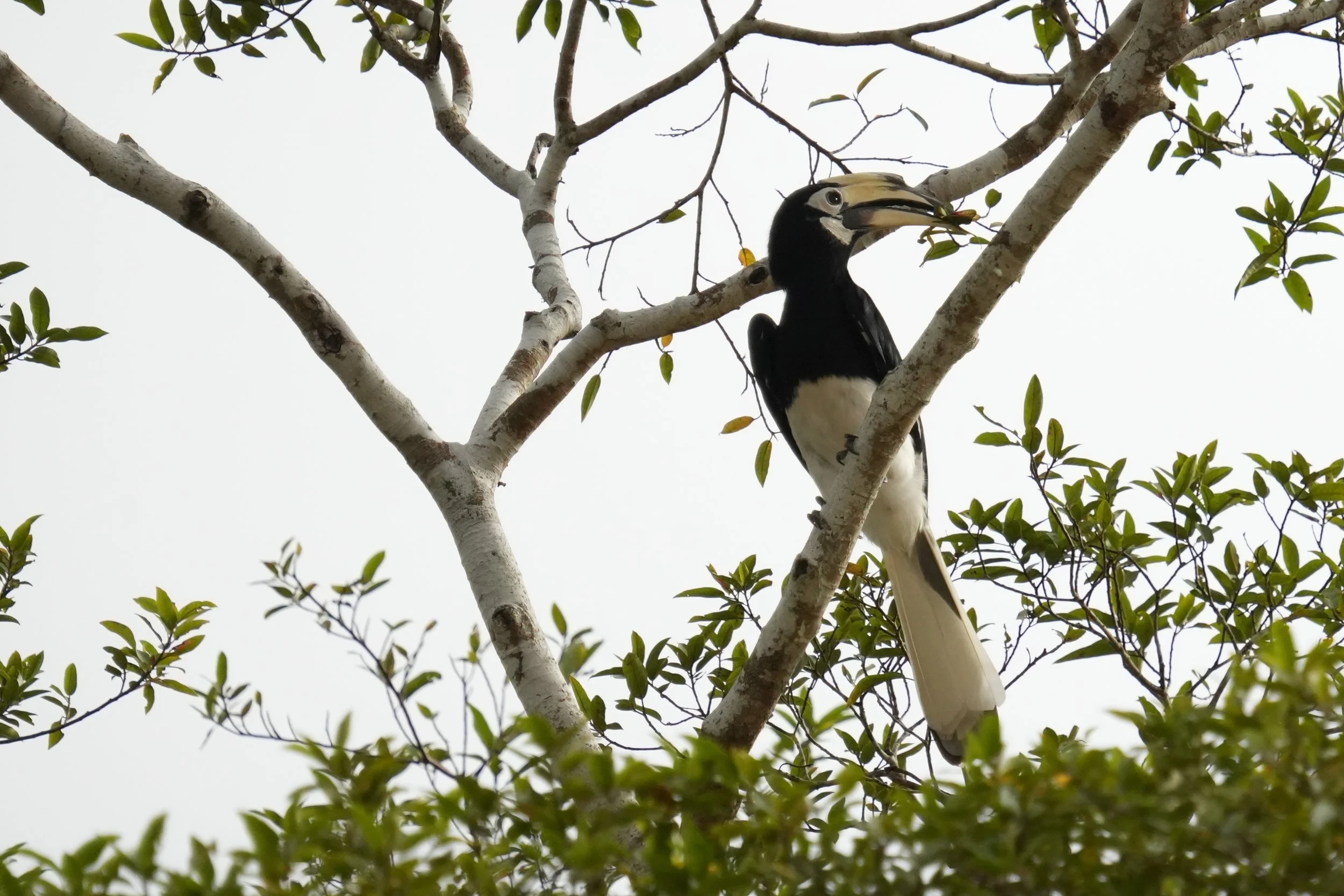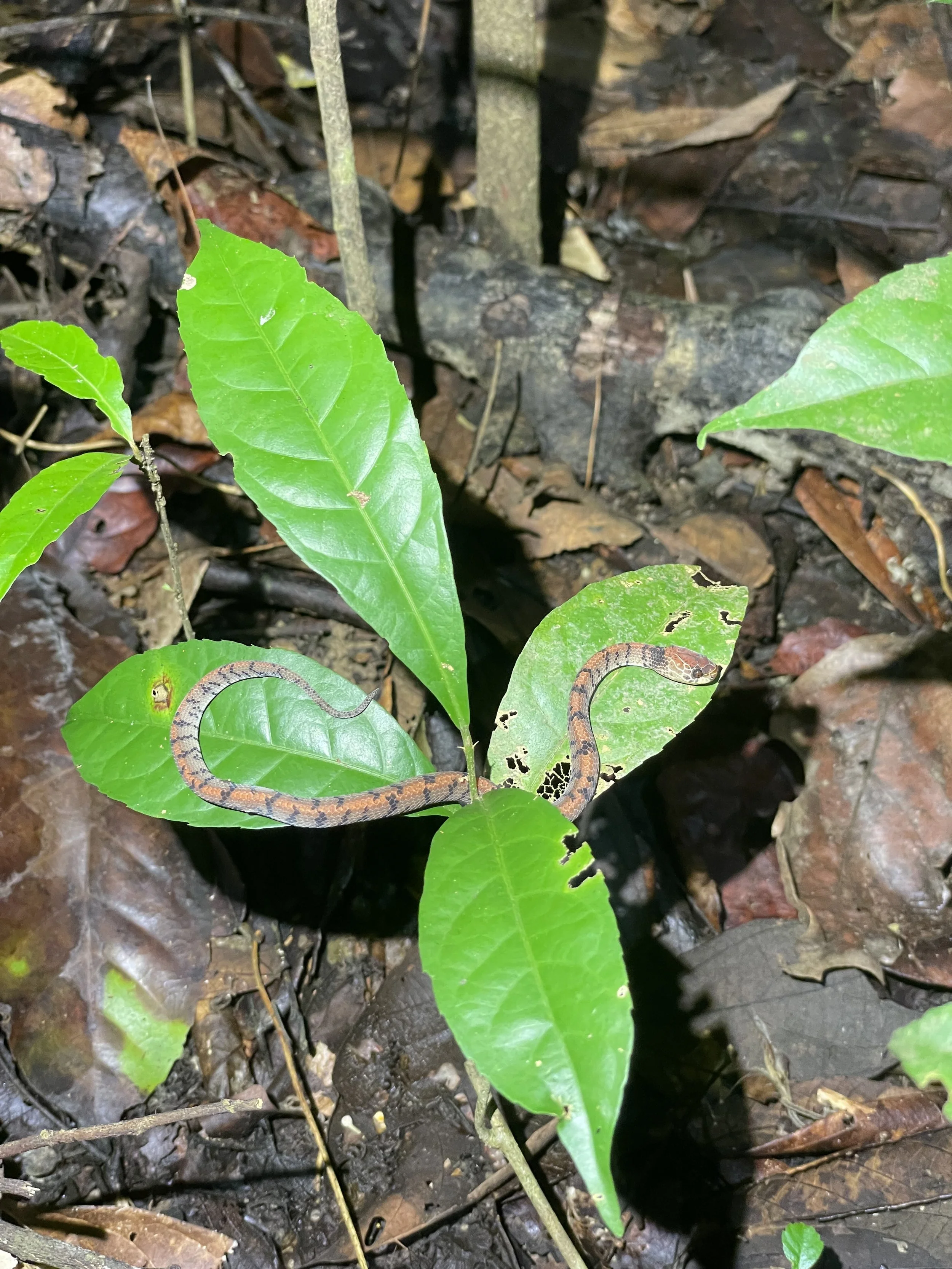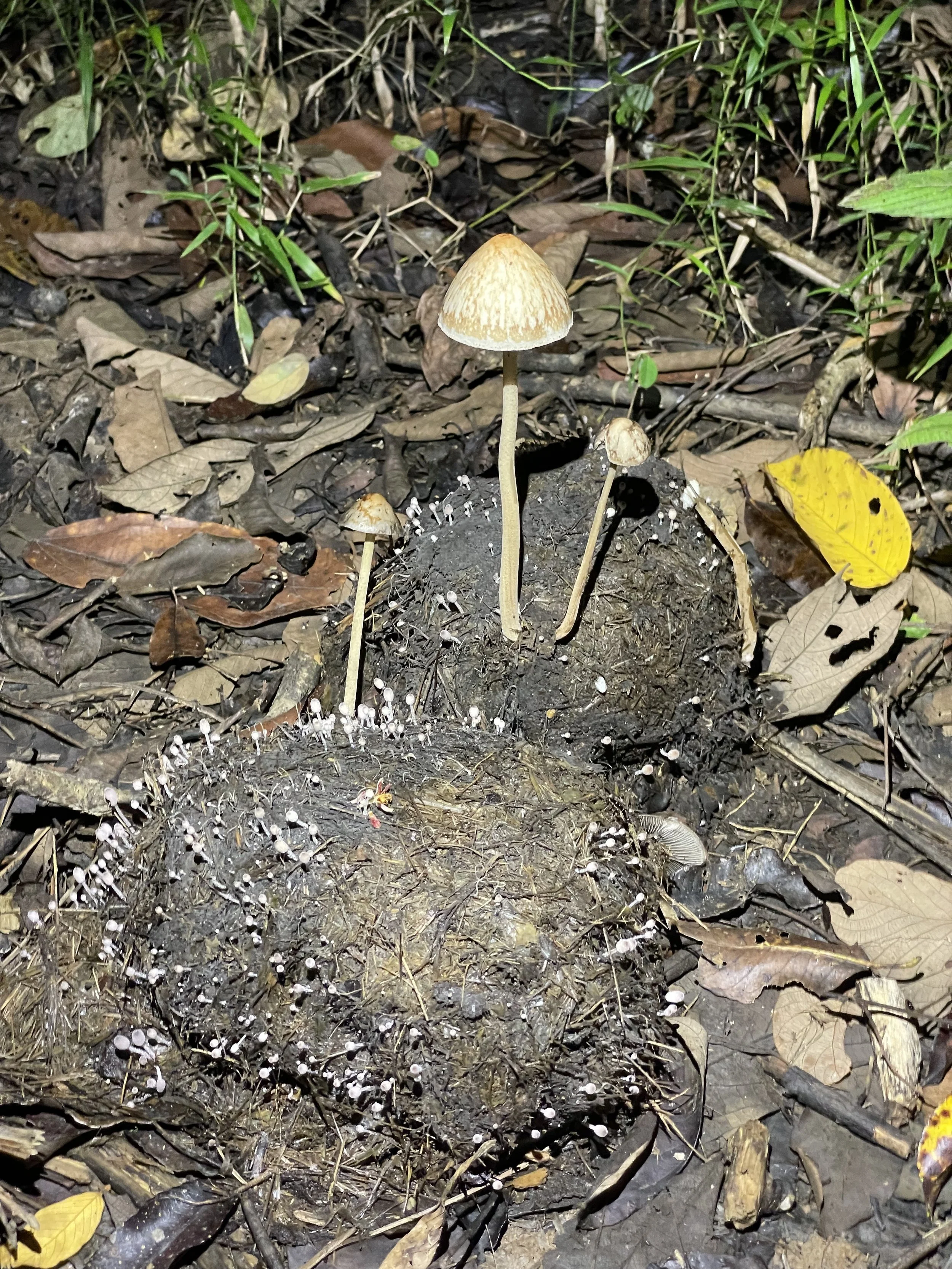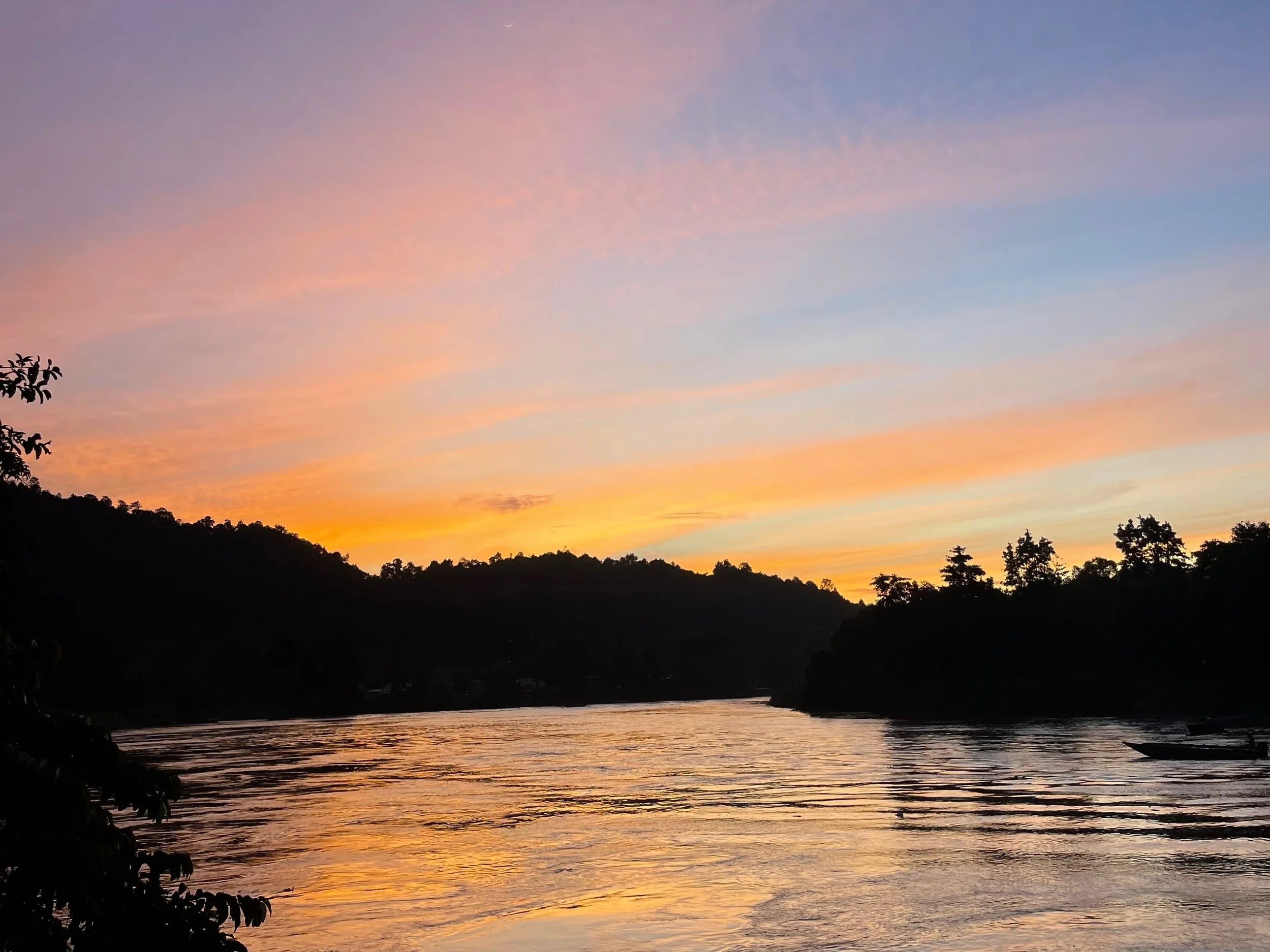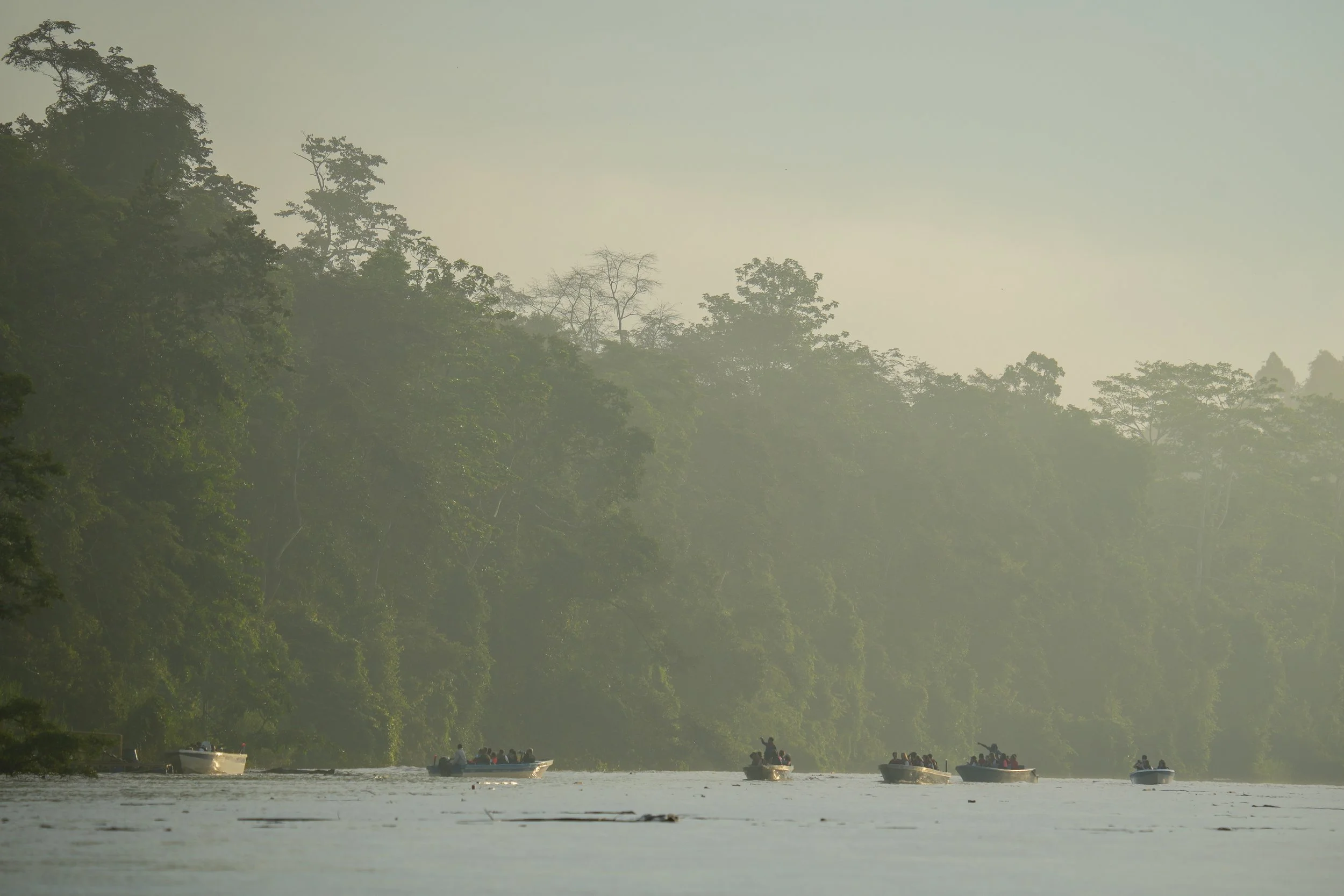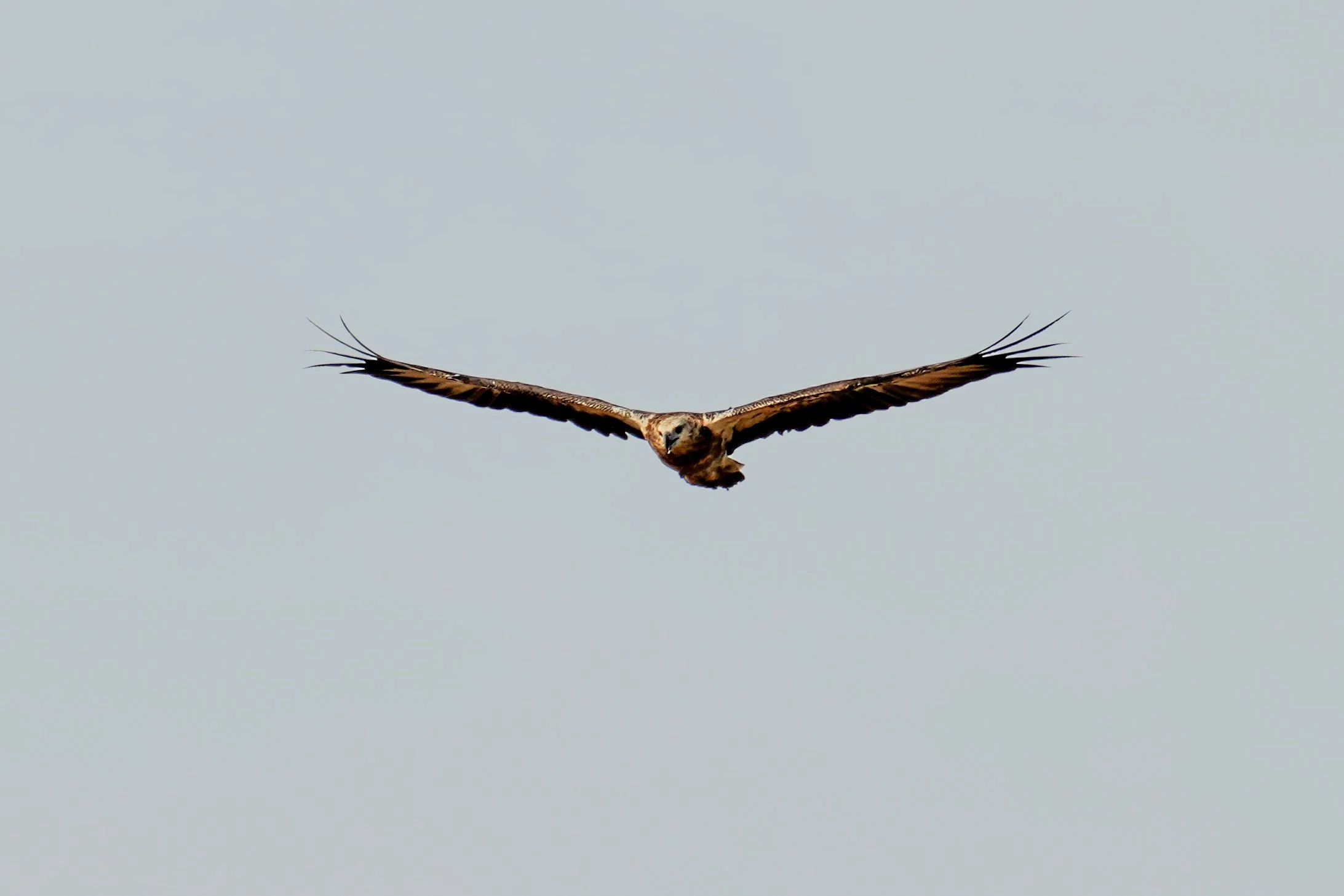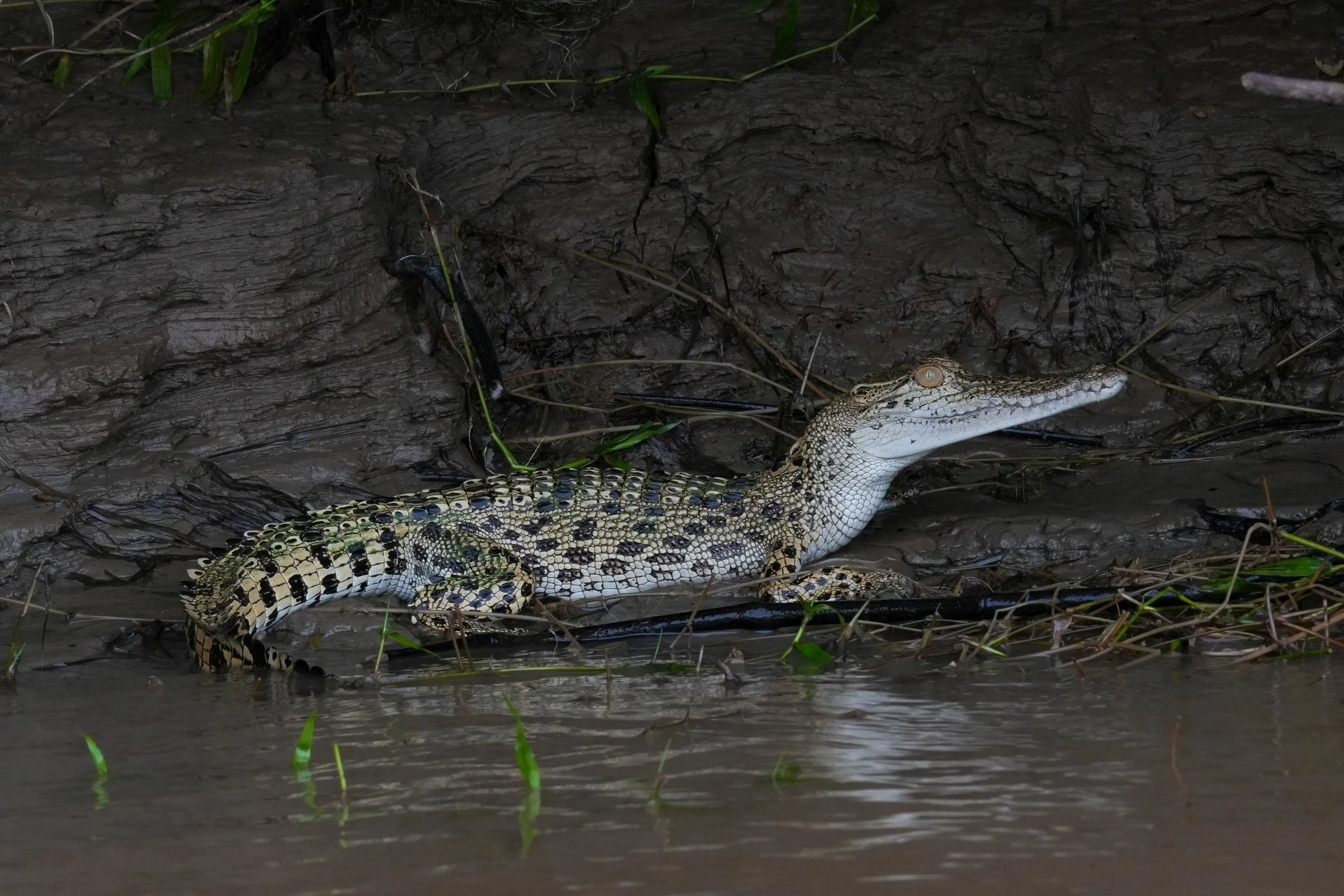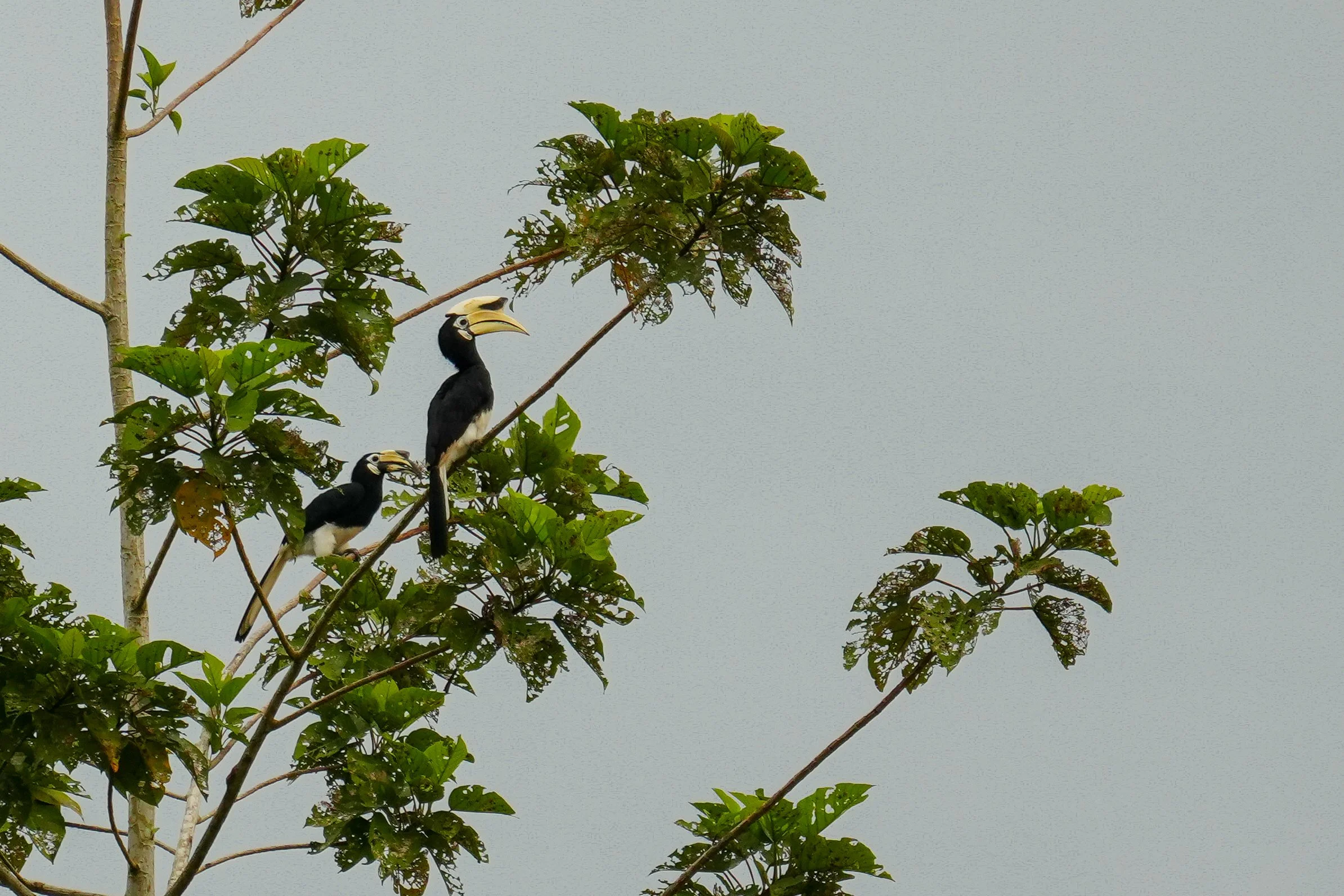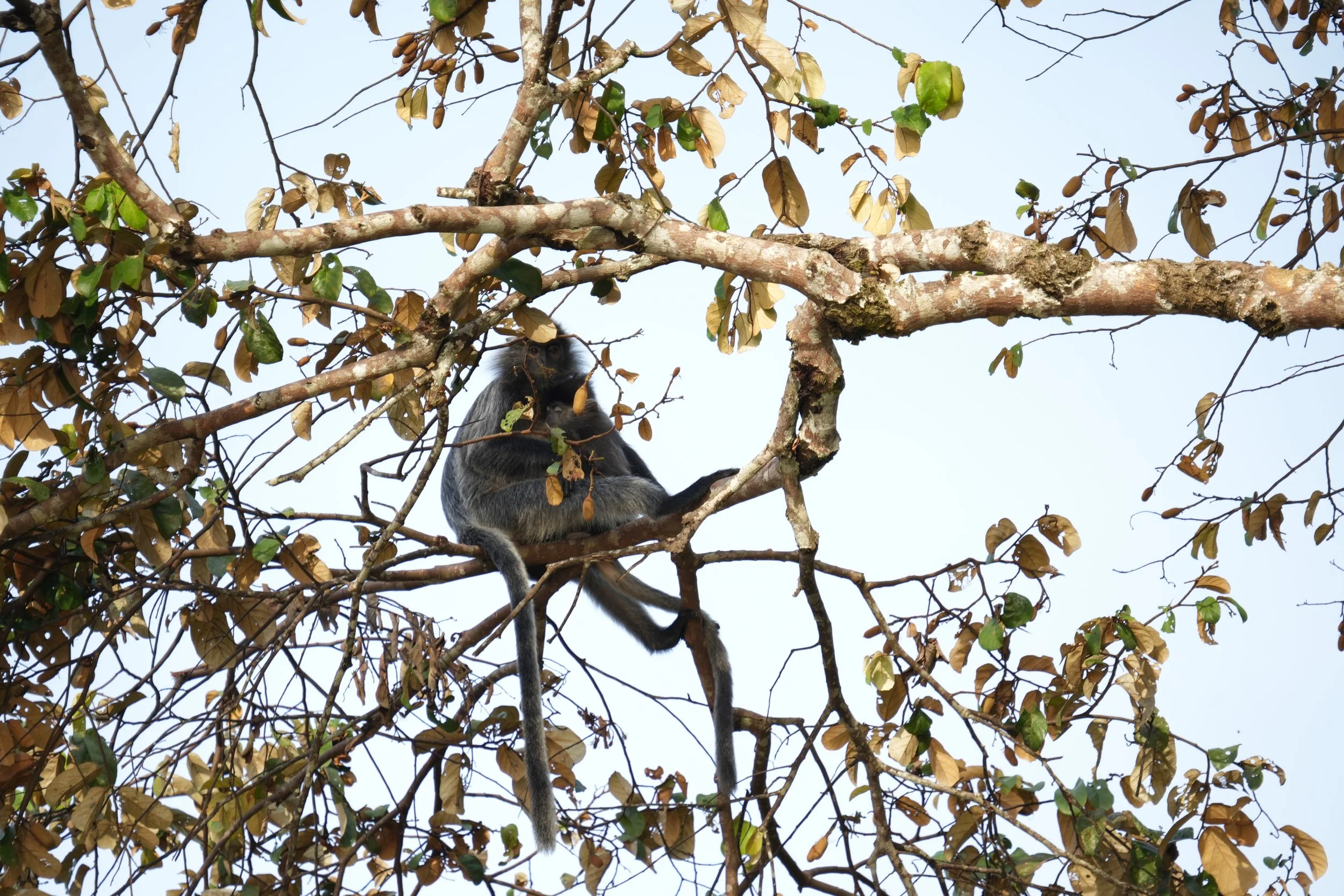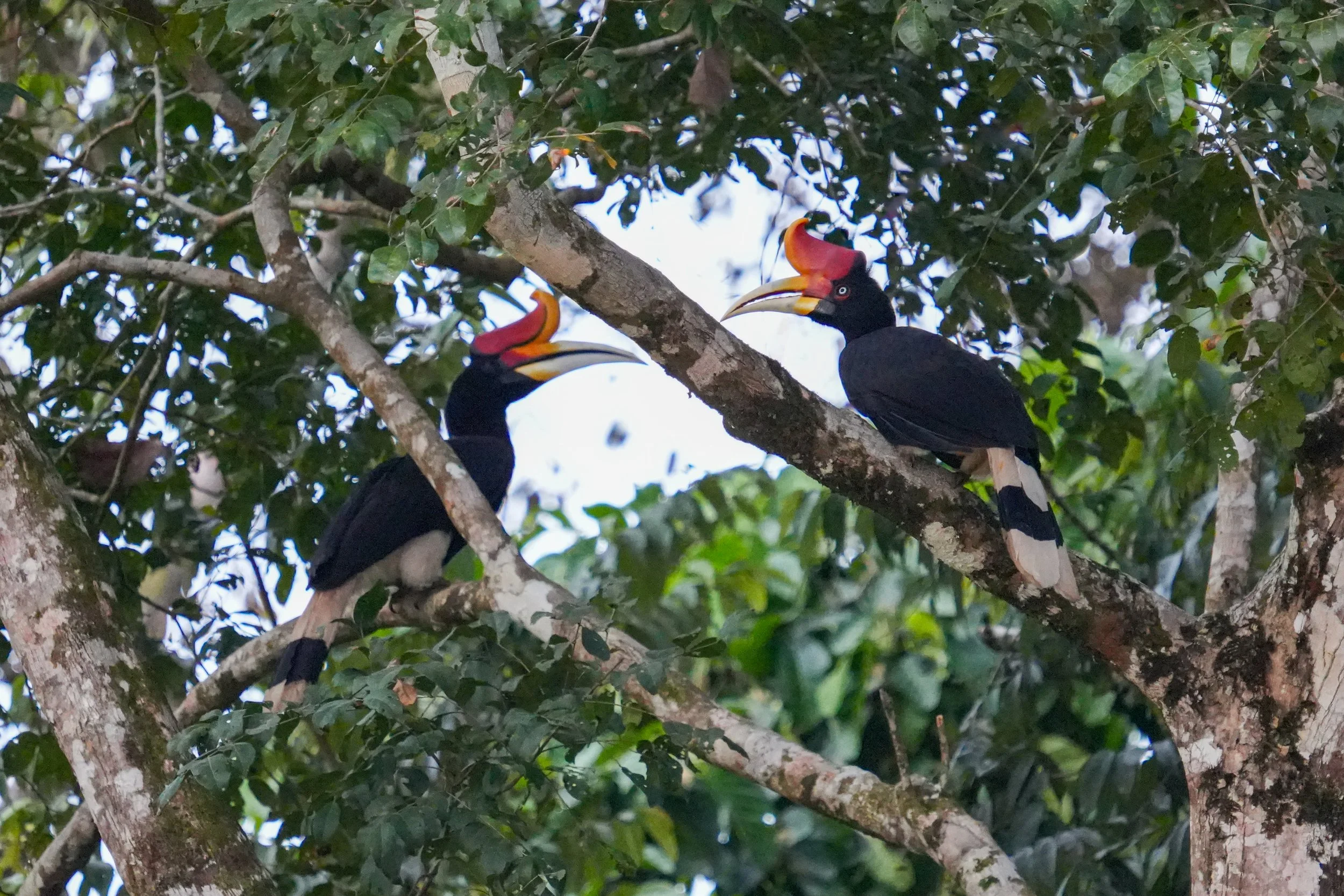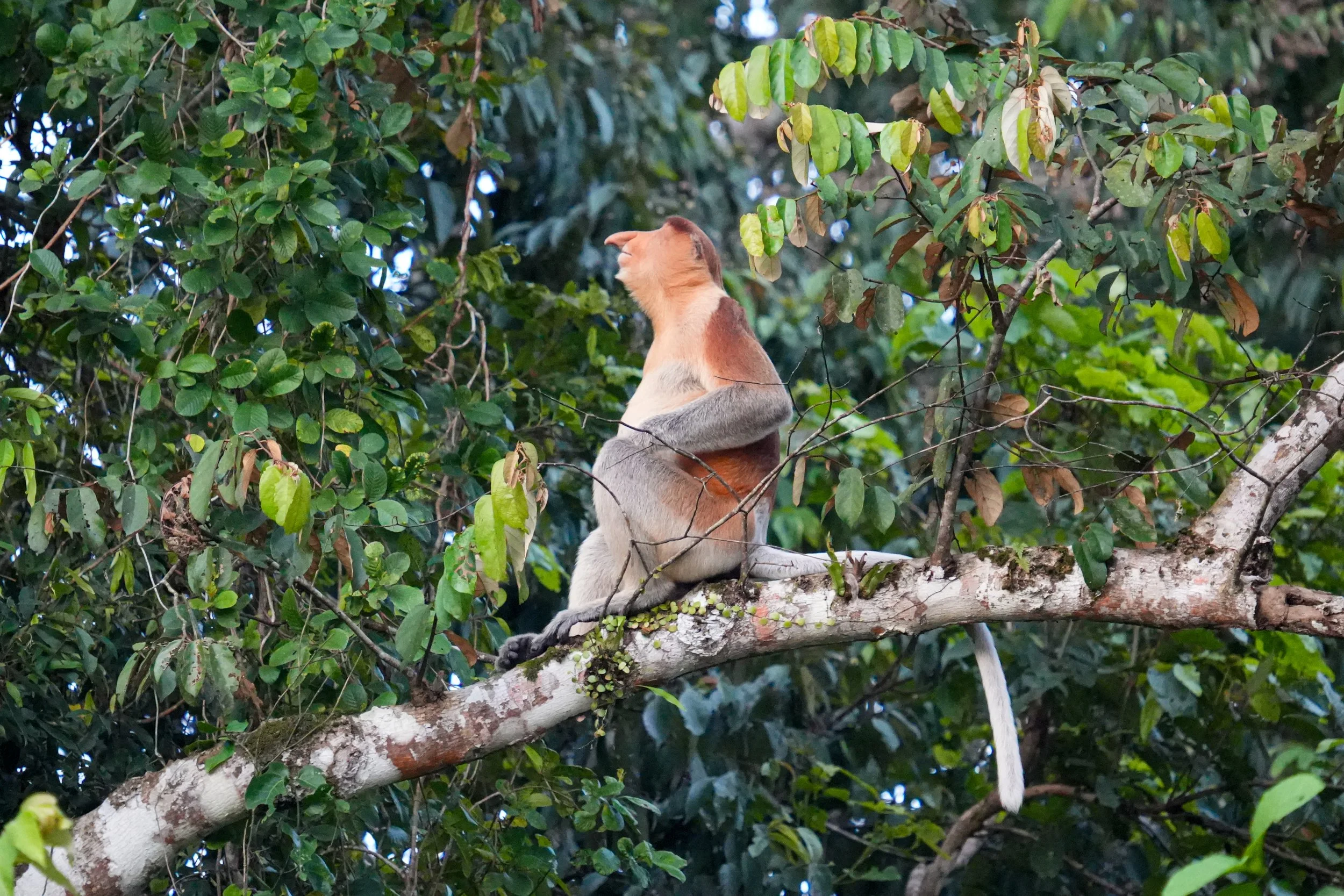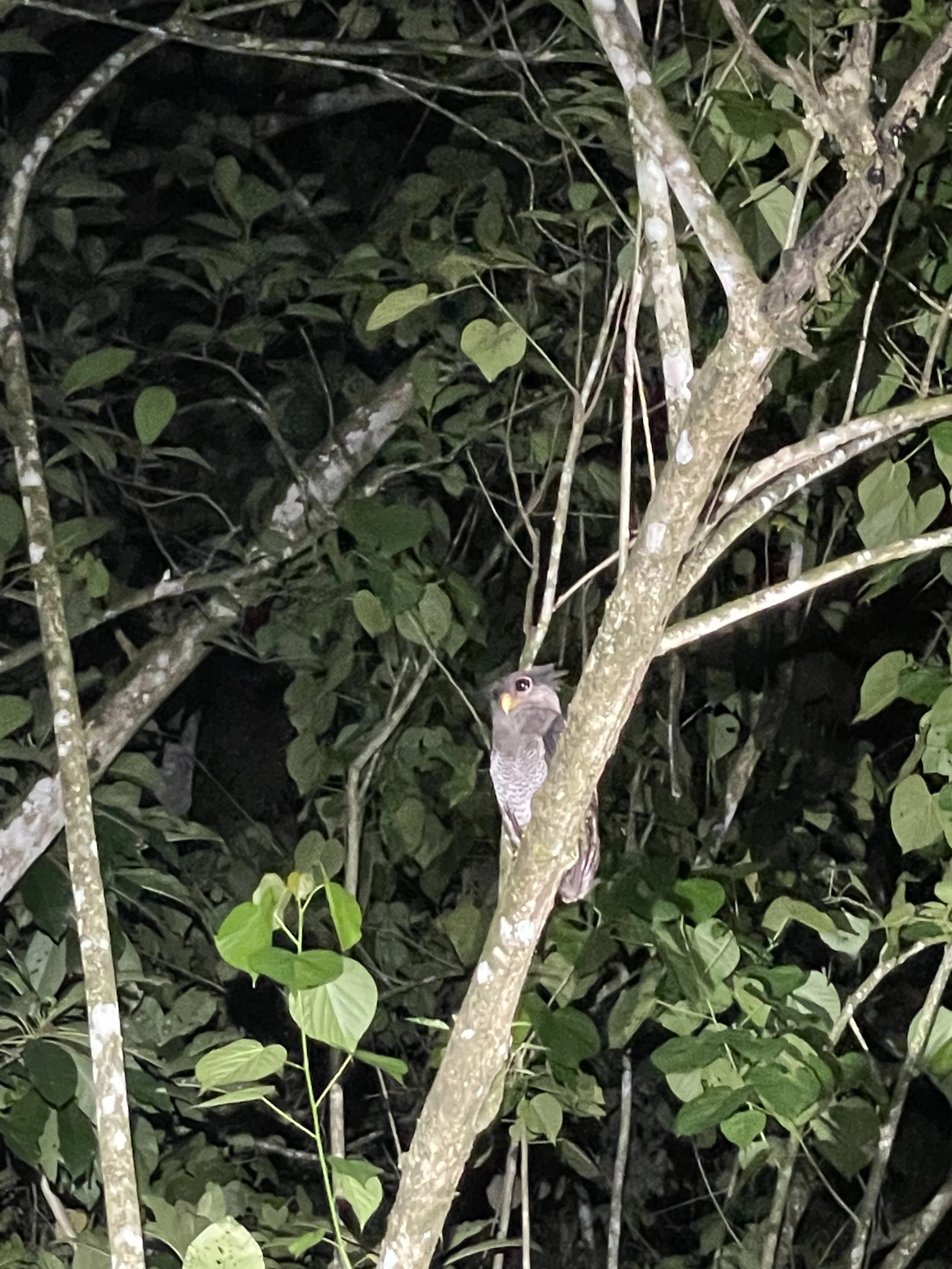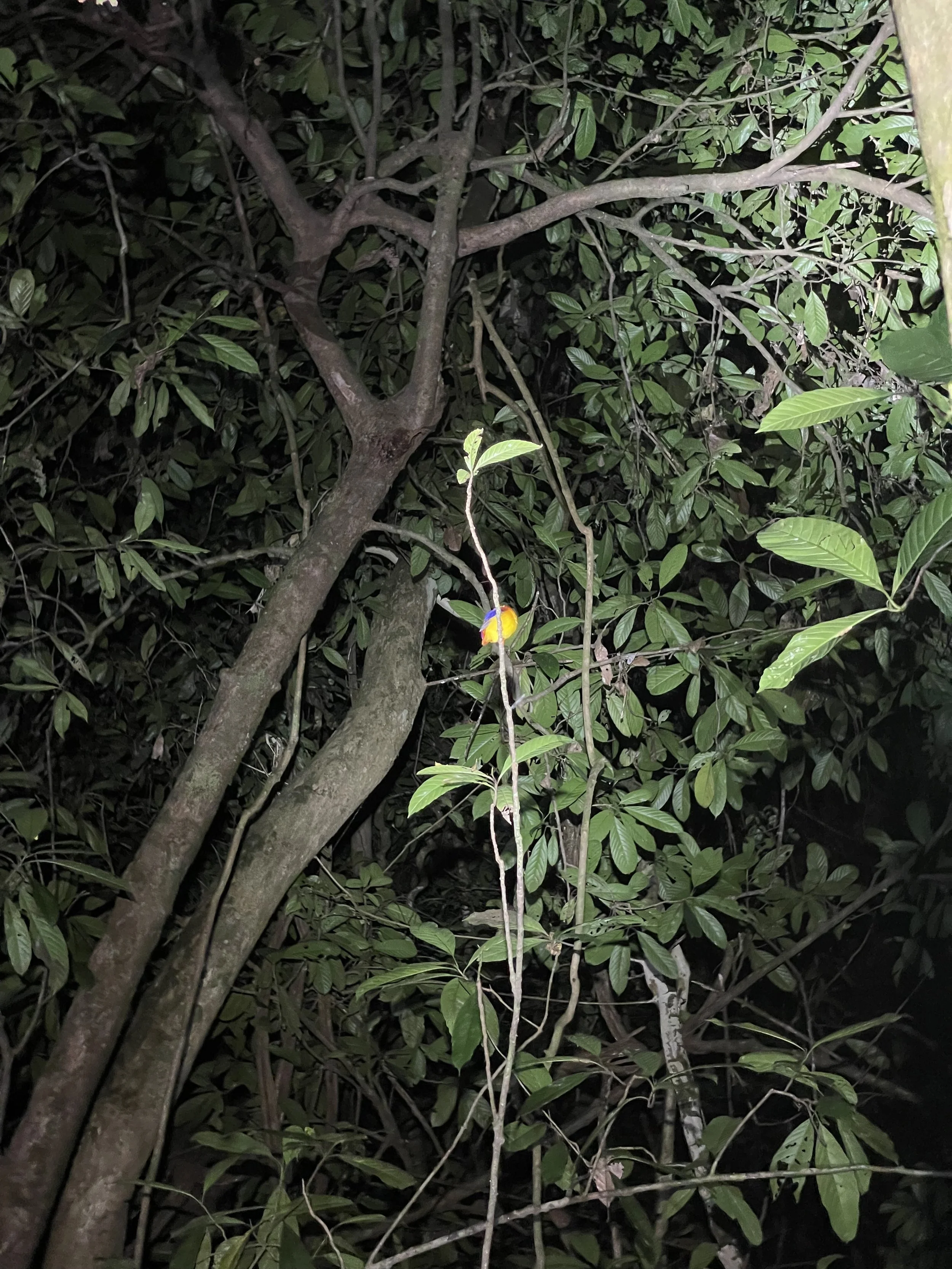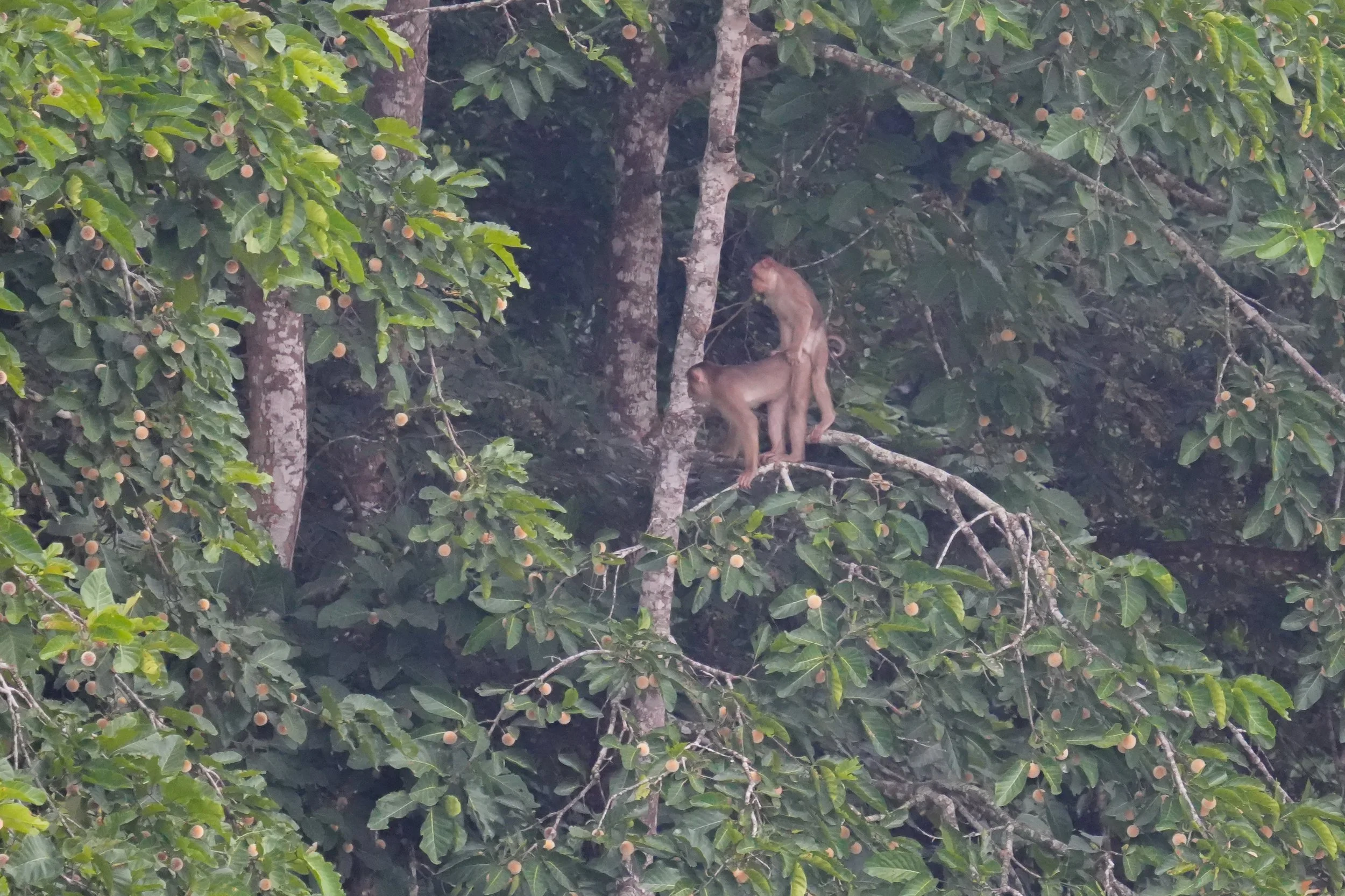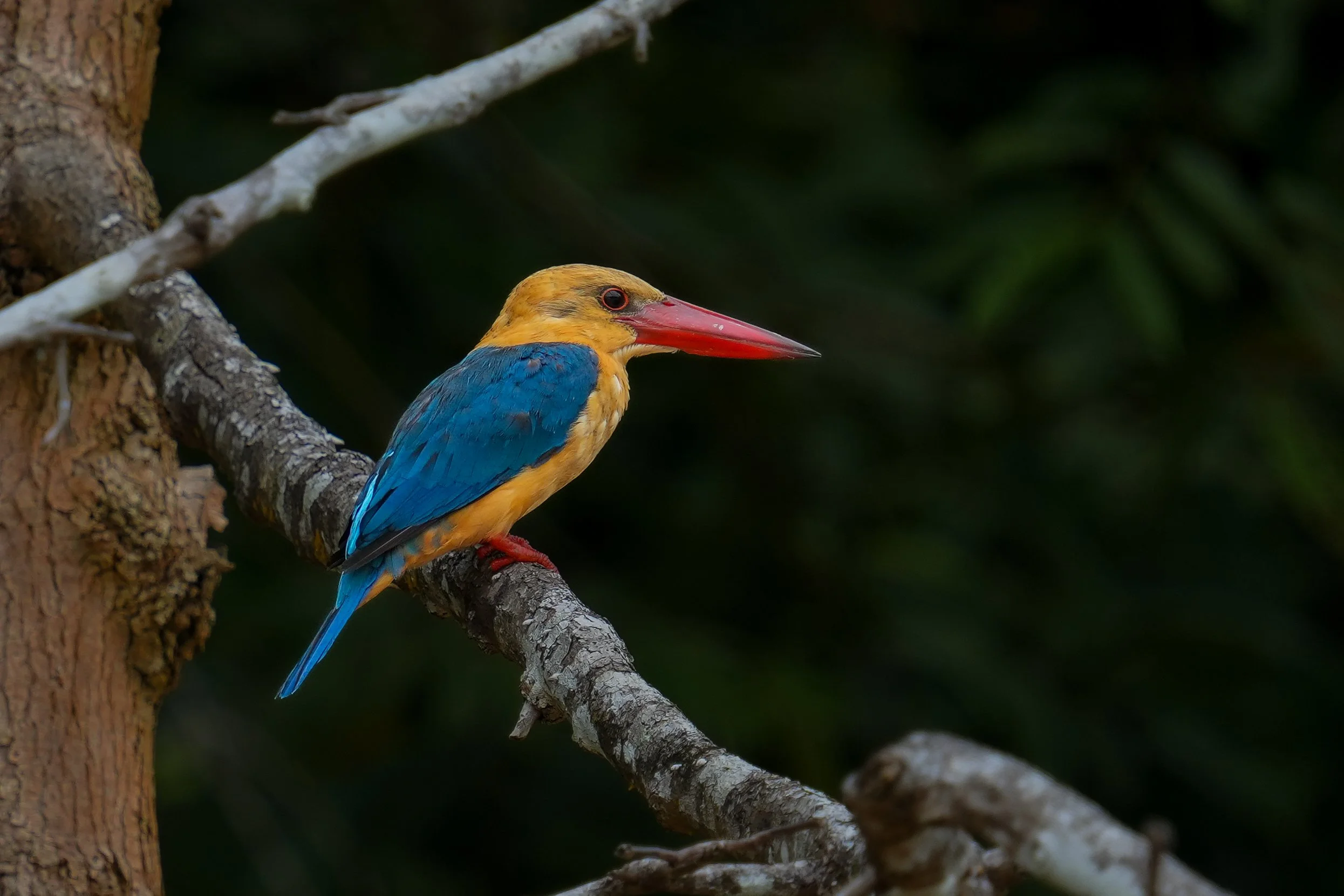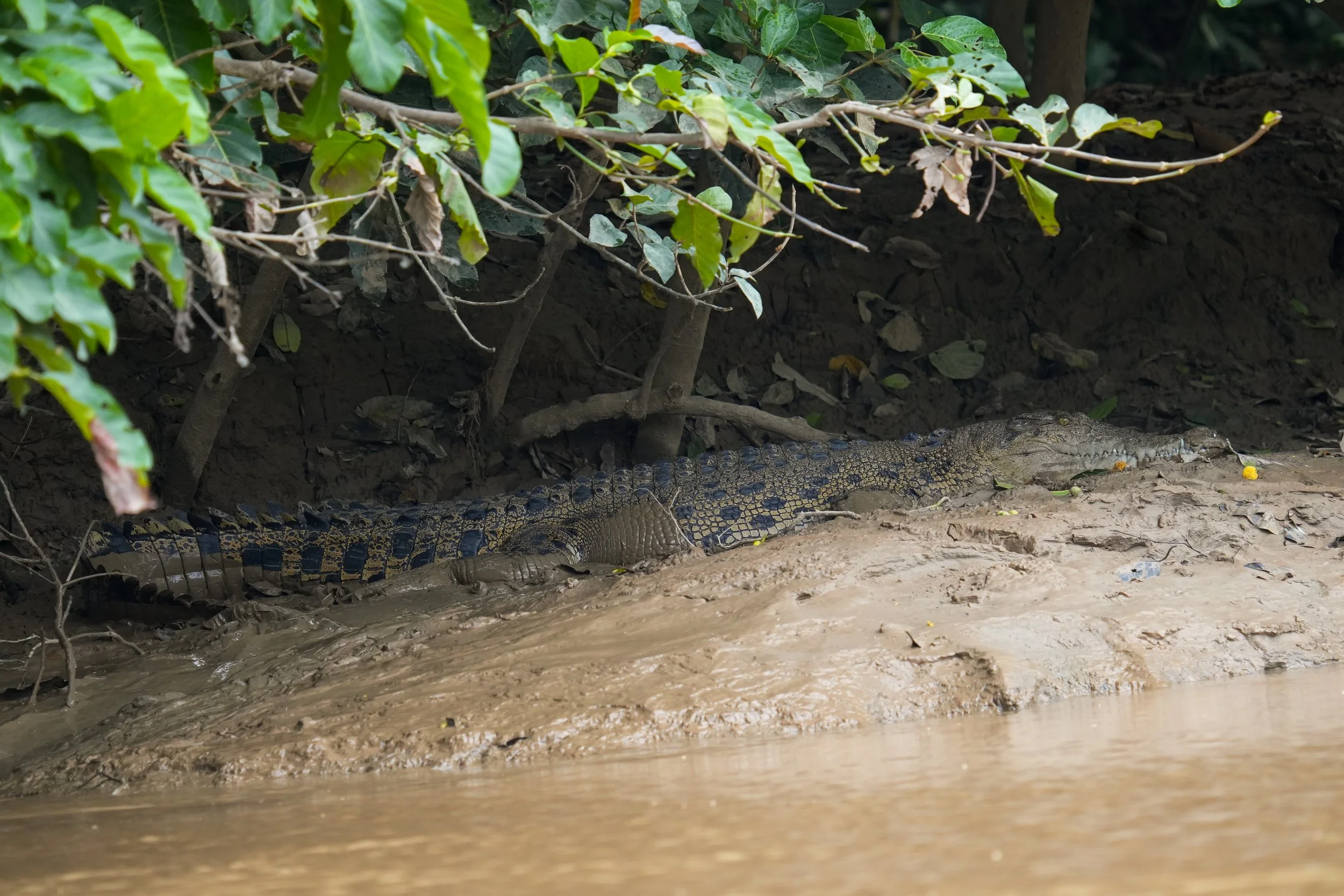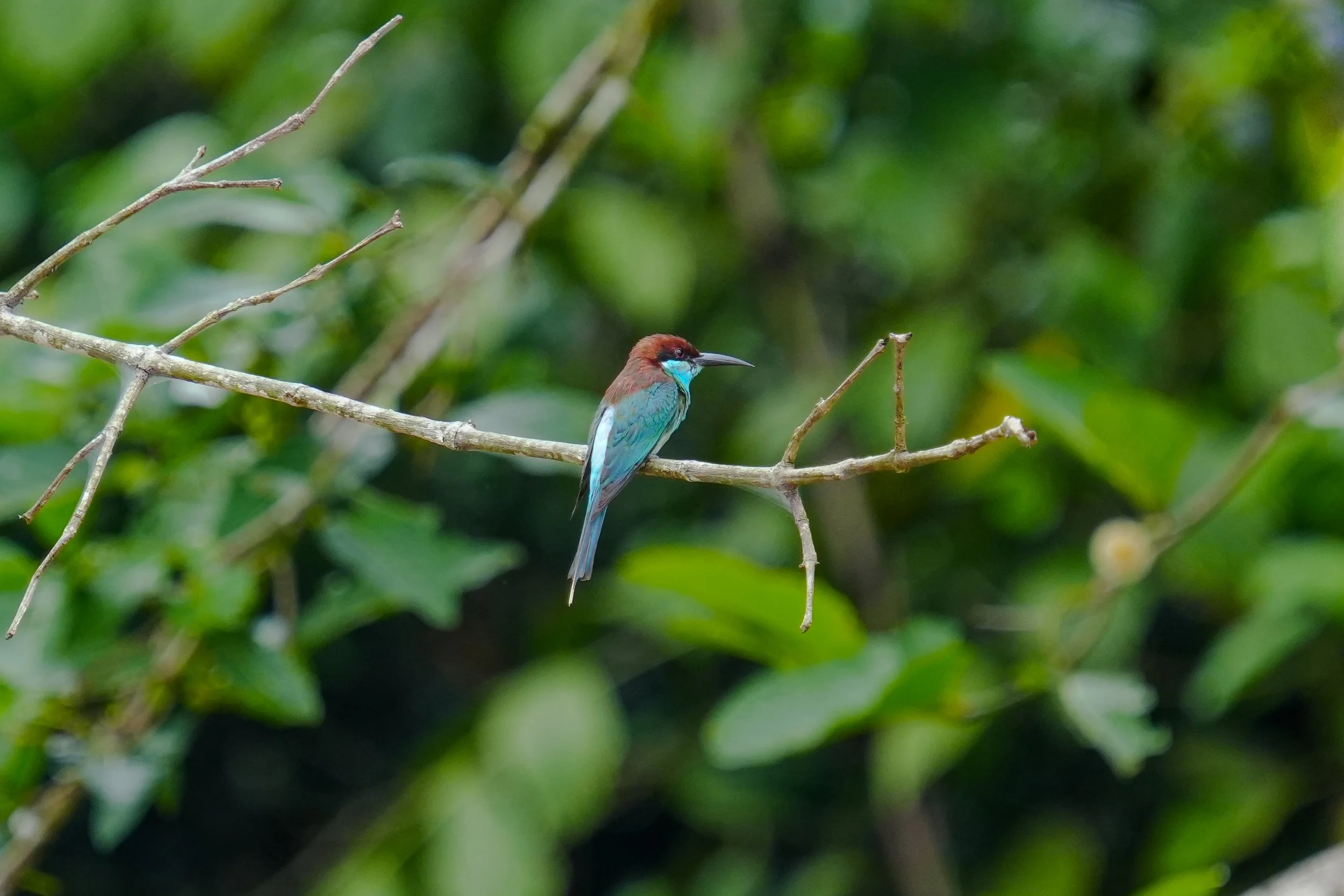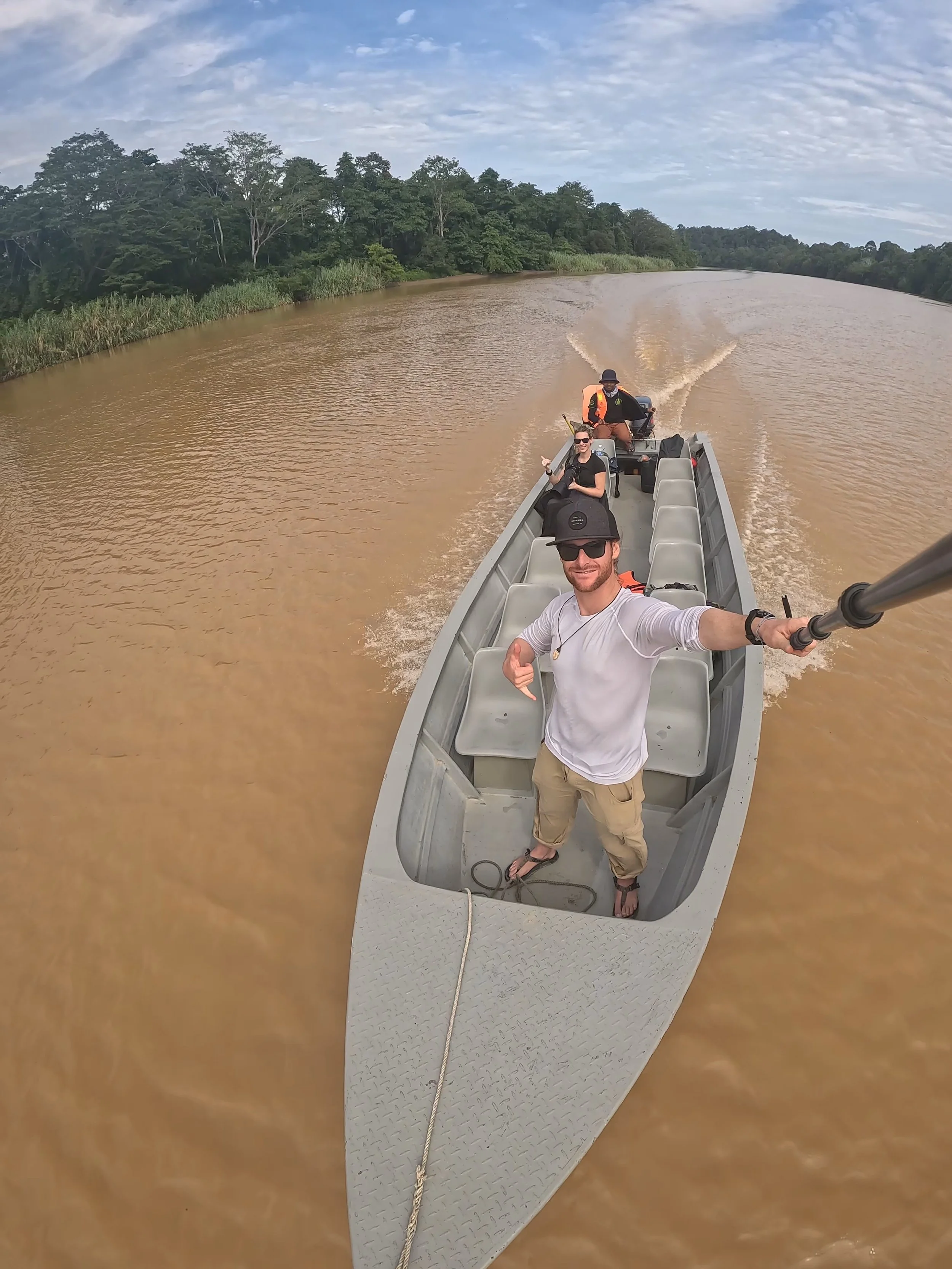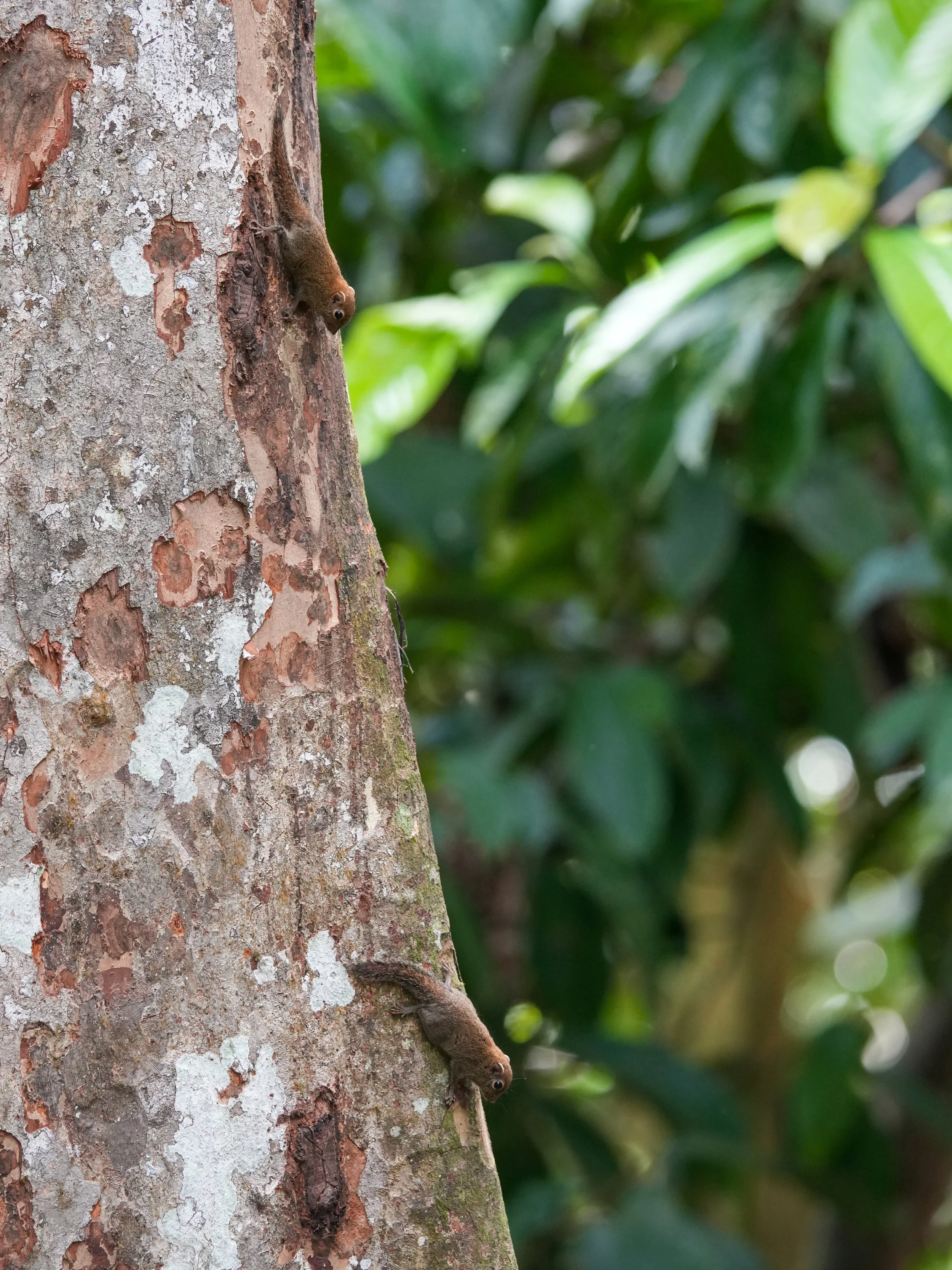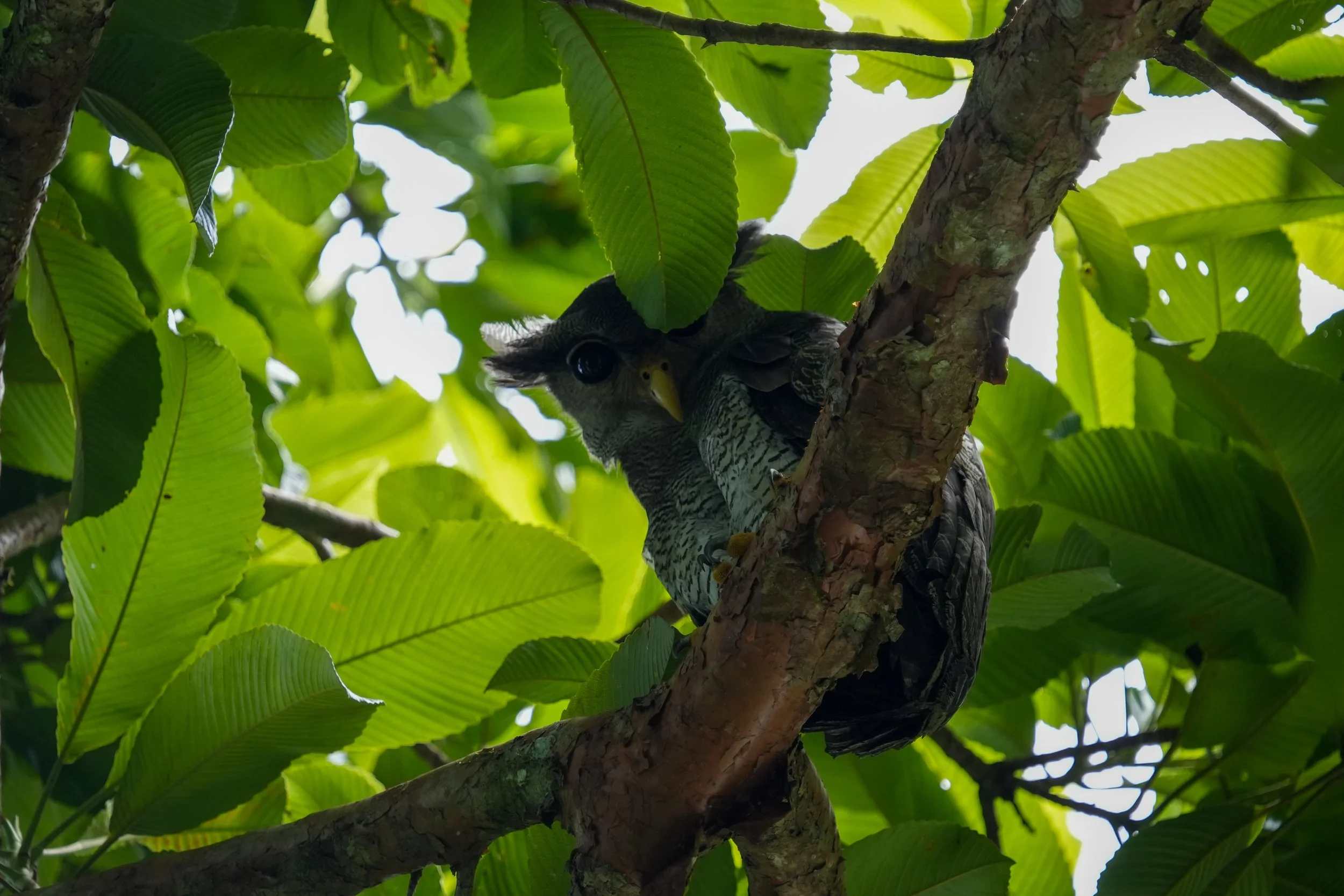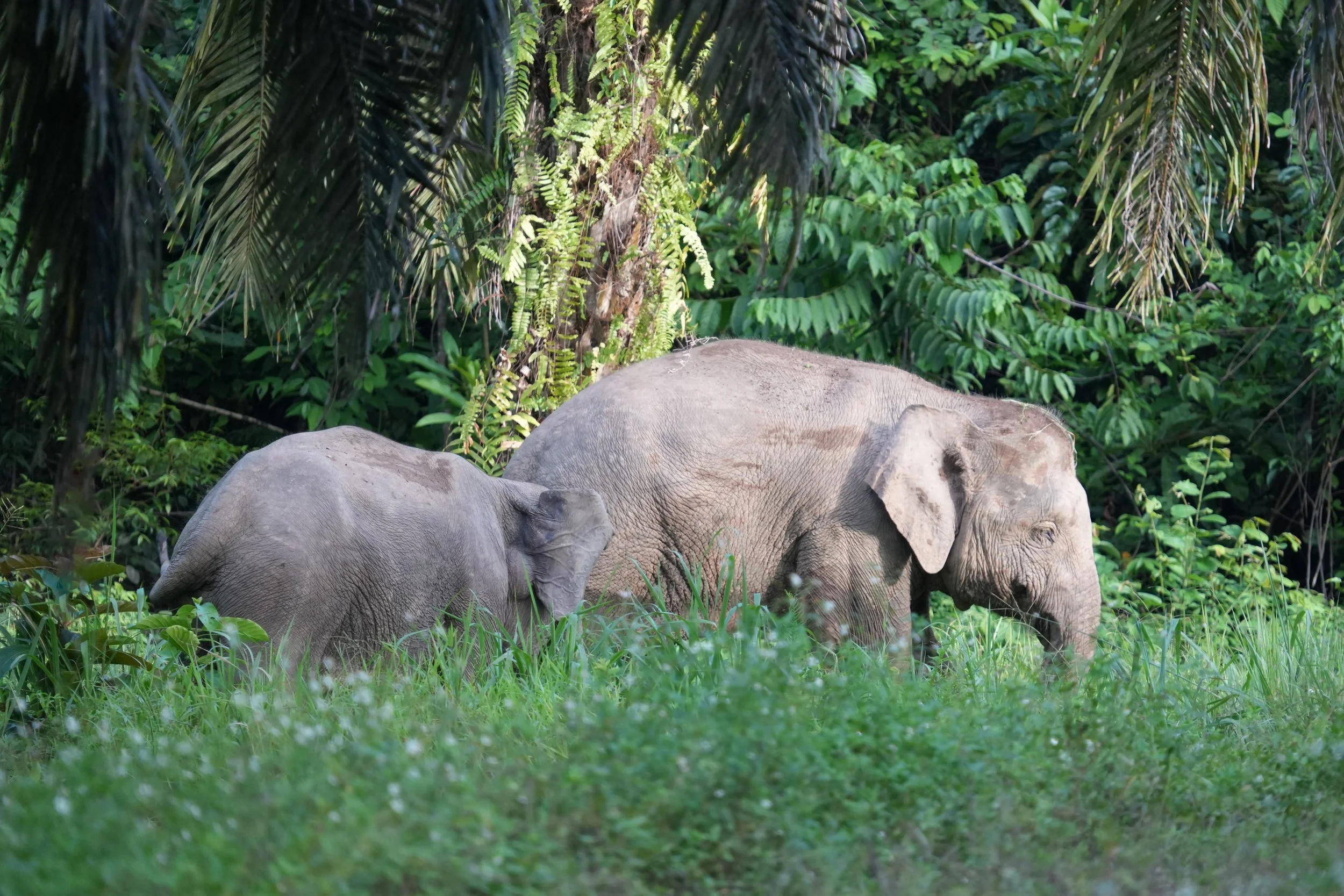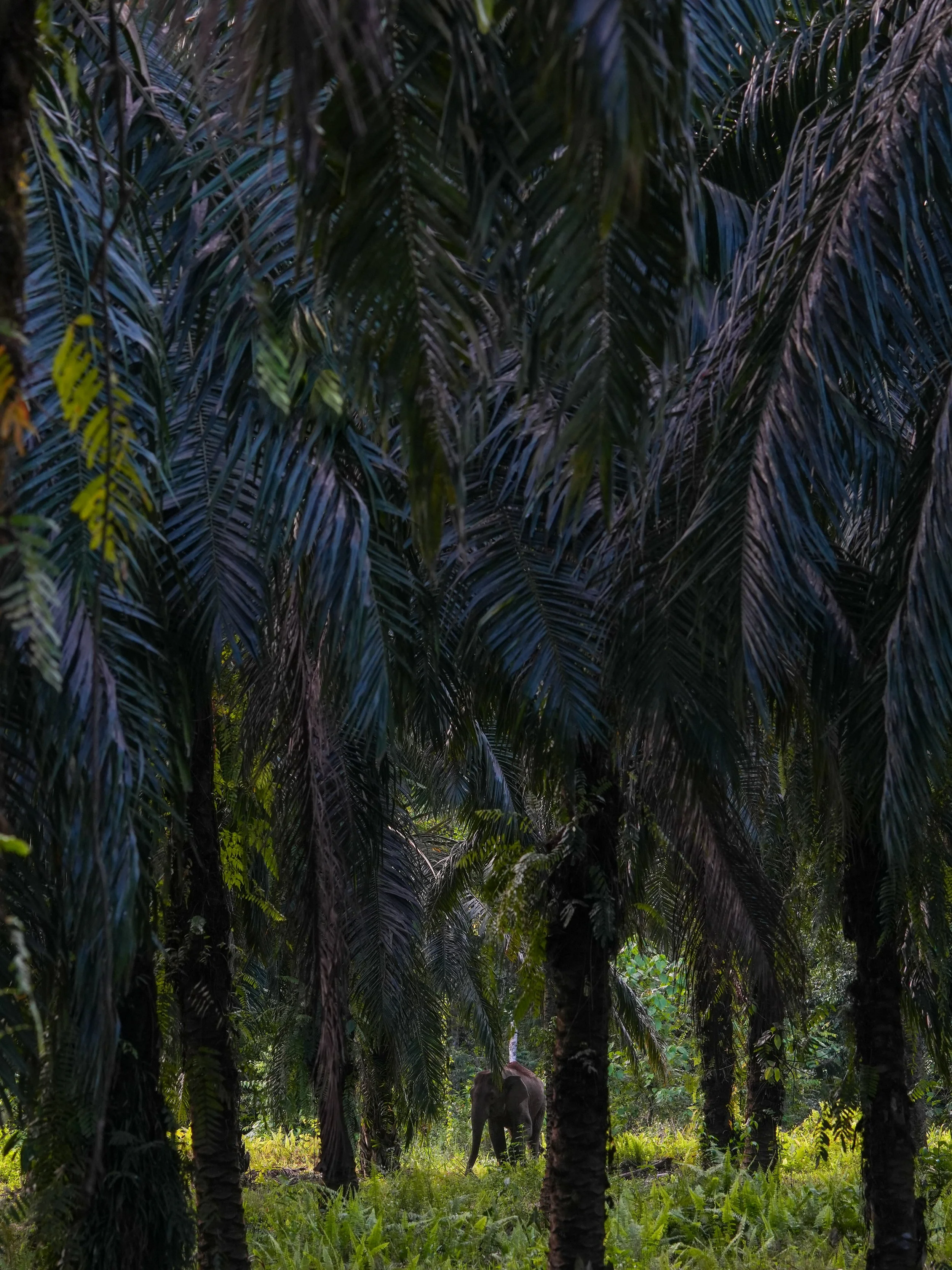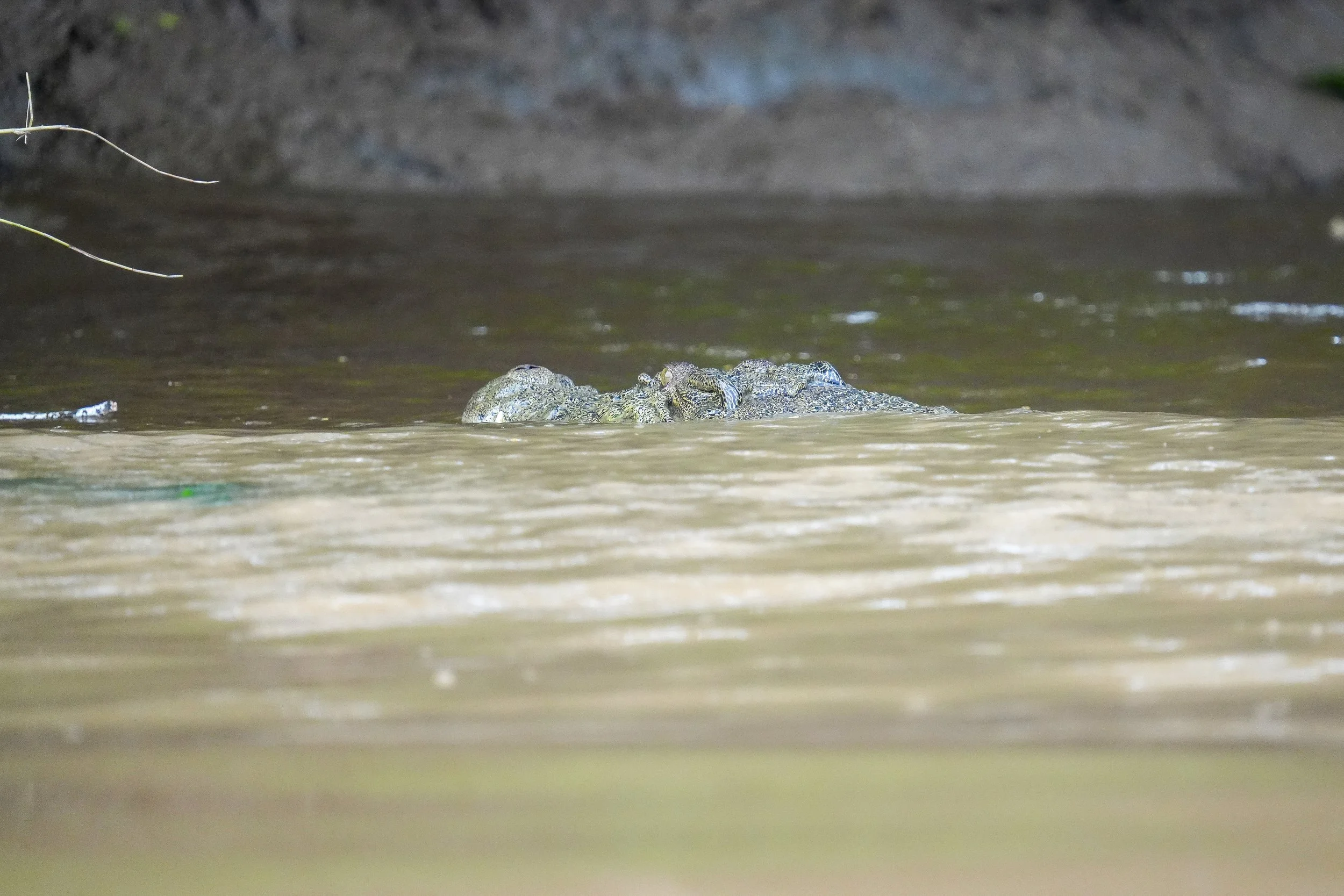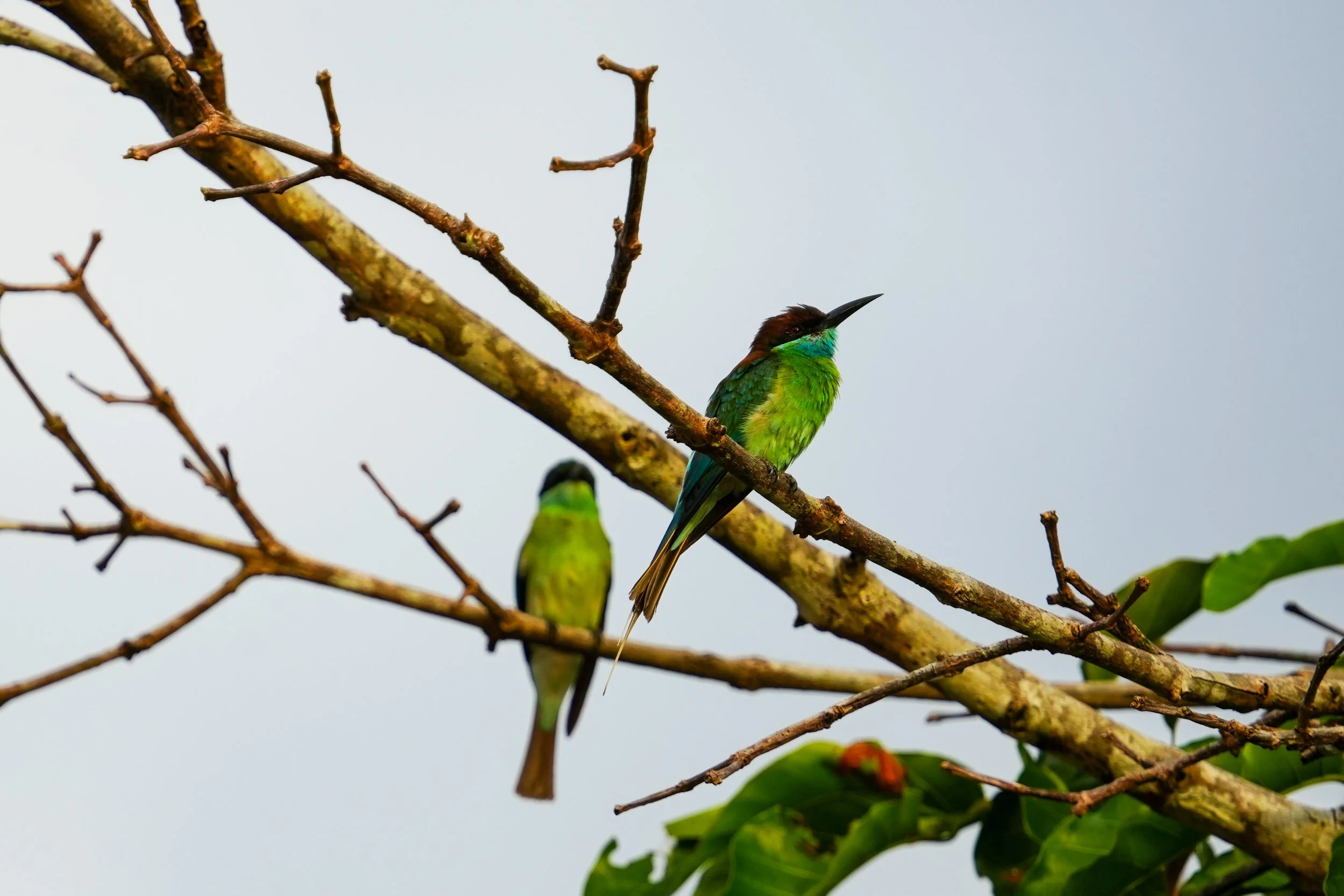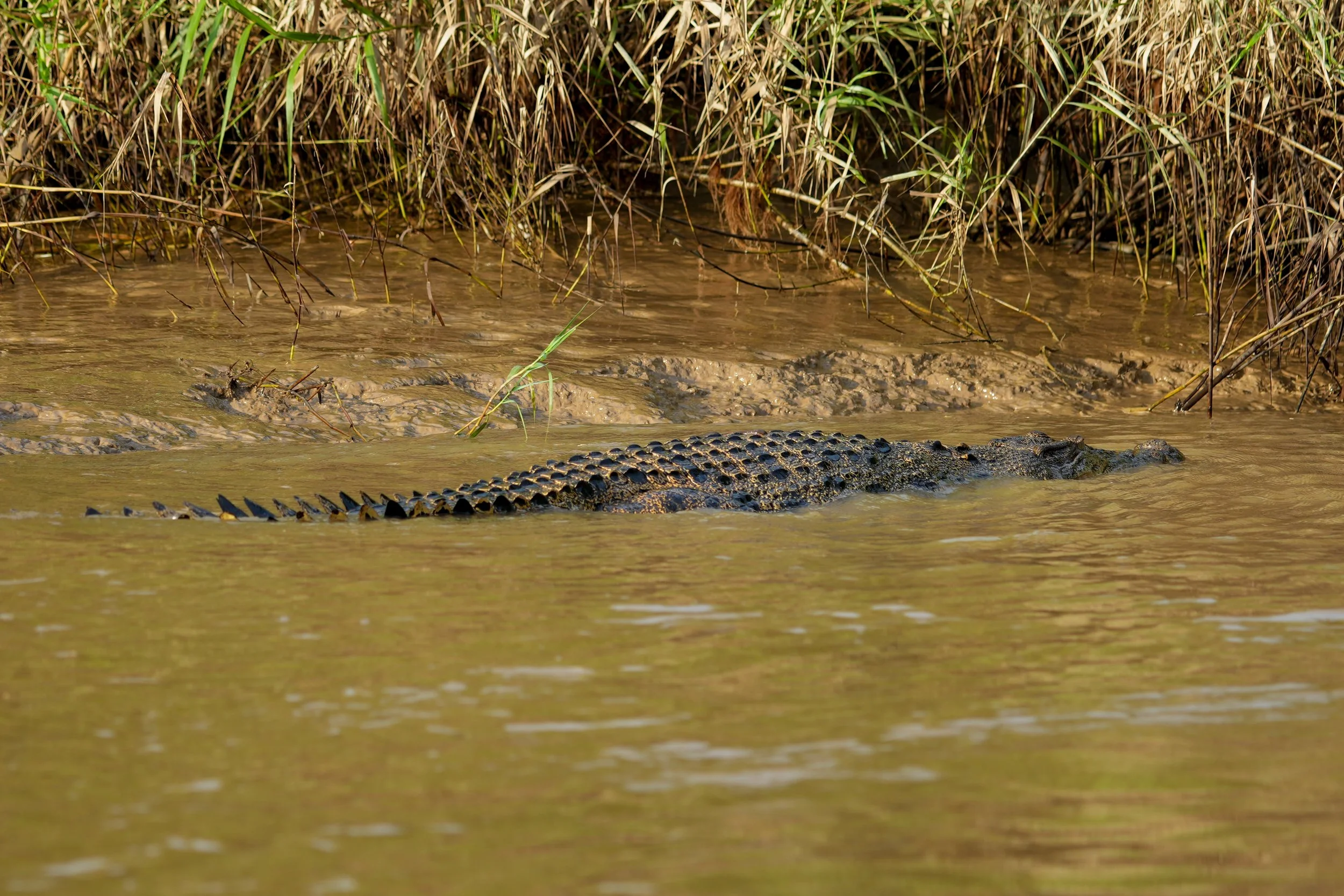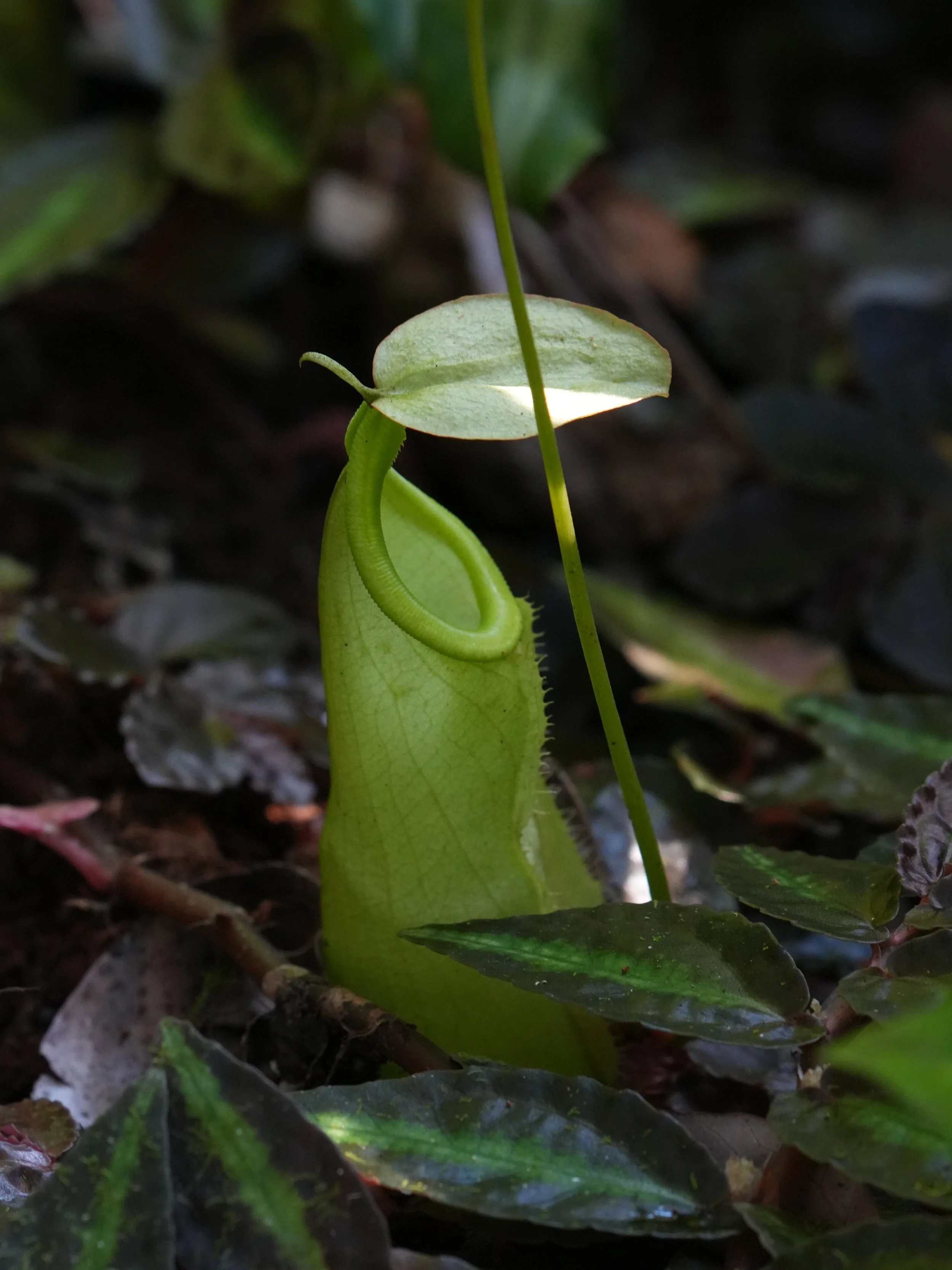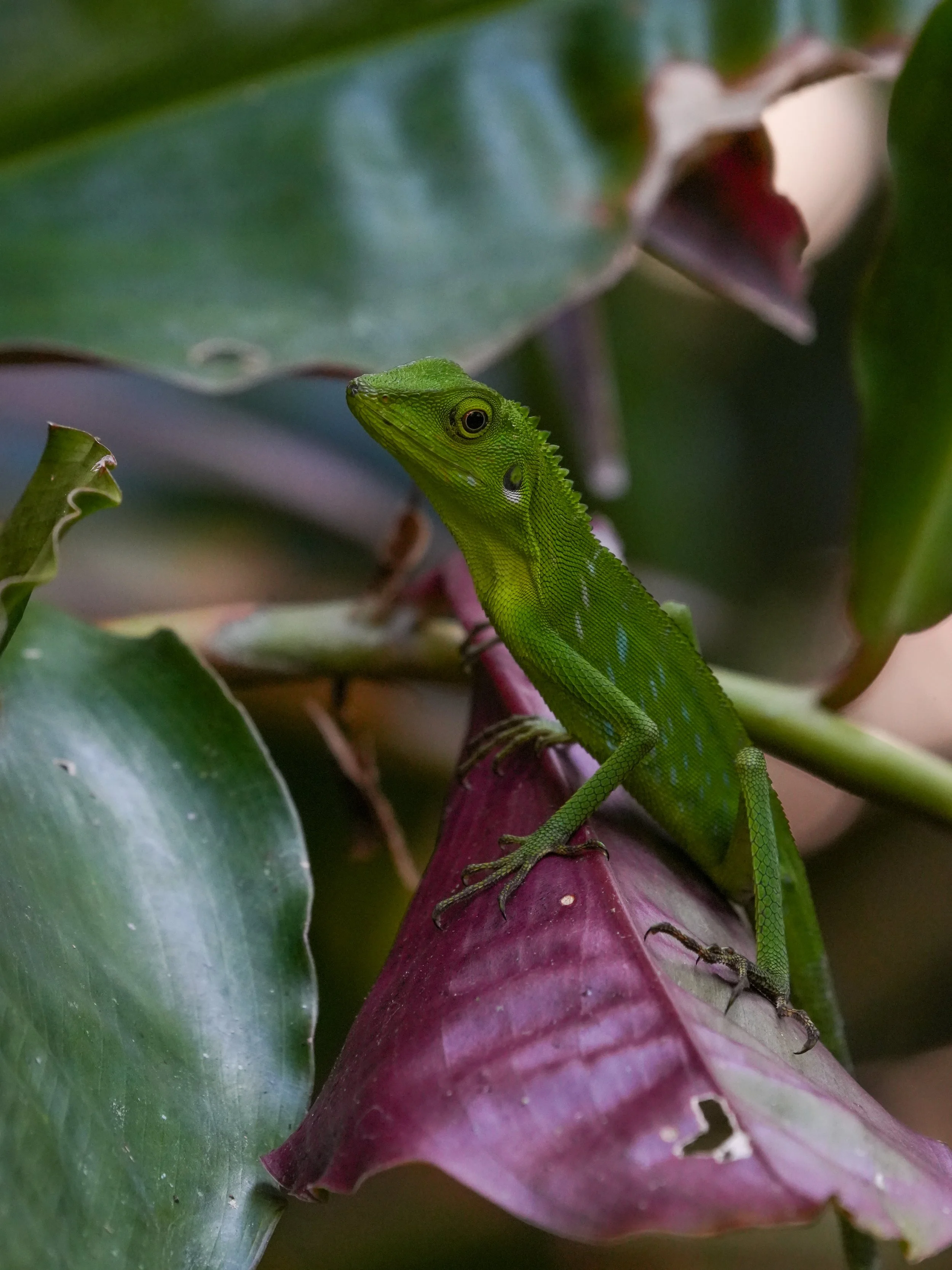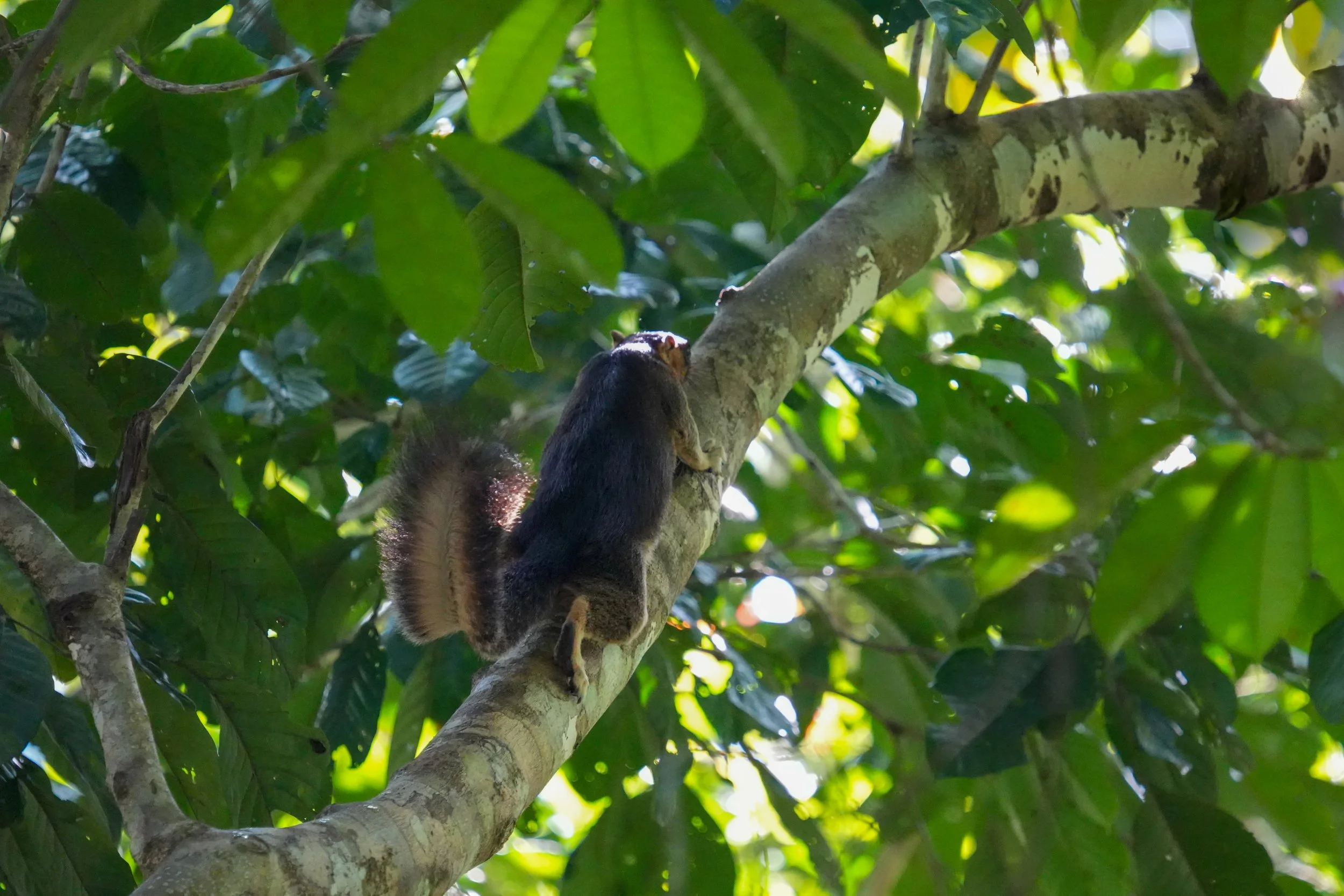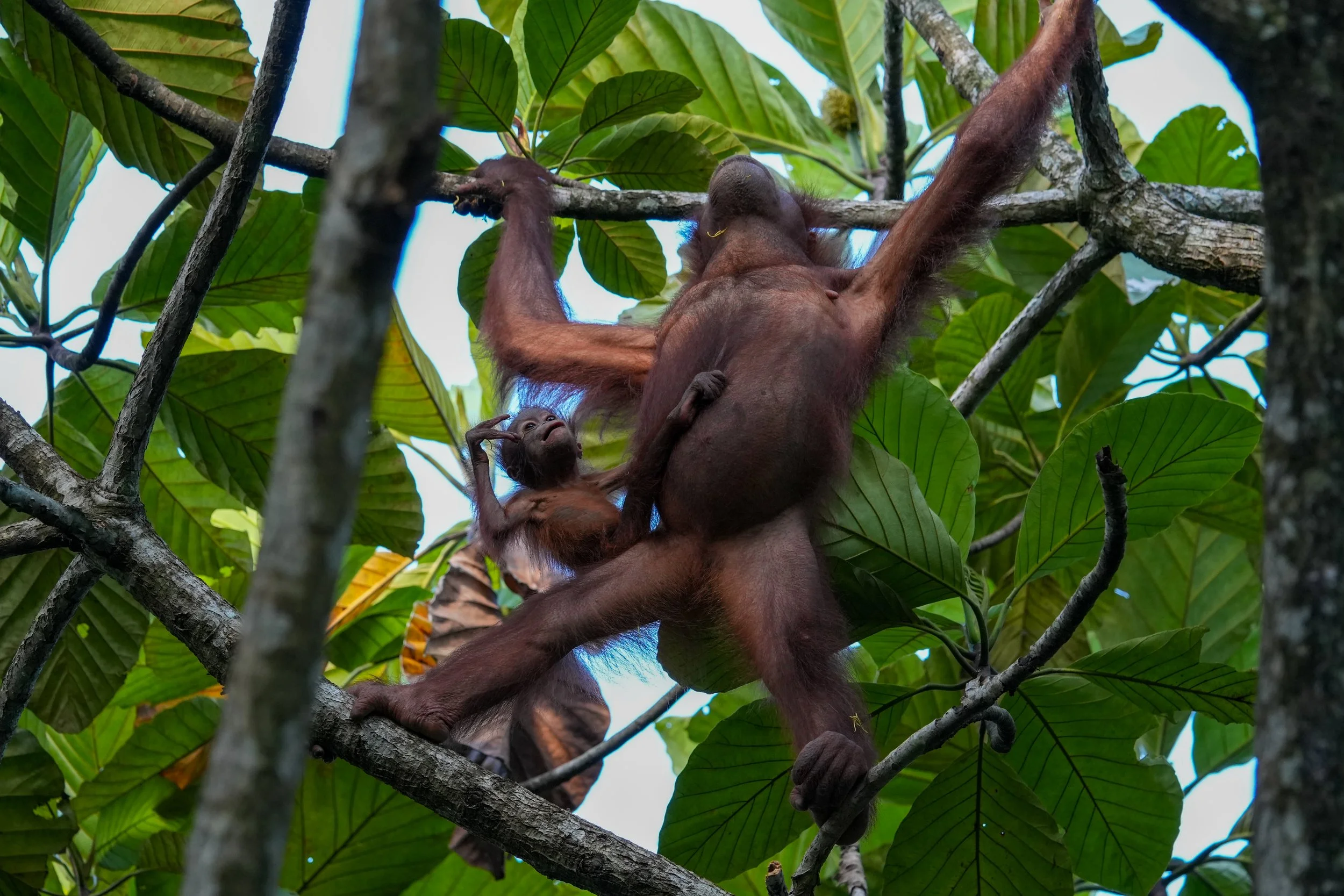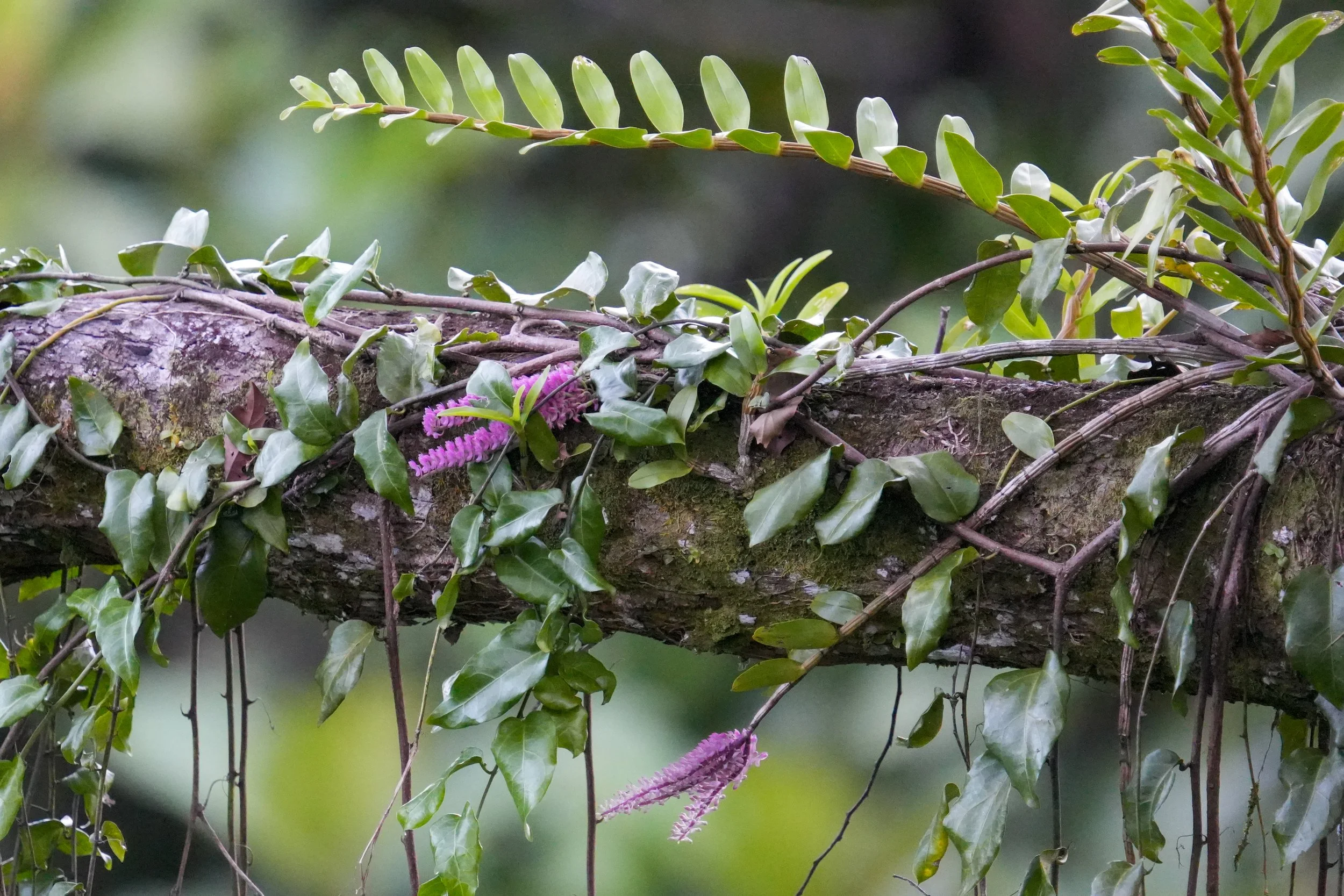Kinabatangan River
Borneo Blog Part 3
Day 6
July 15th 2023
We left Tabin at 10:00, headed to an intersection, and got picked up around 14:00 from the van driving people to the lodge. We planned to stay one night at one spot and then two nights at another because I wanted four full days to see the wildlife.
We got to the first spot and had an hour before getting on the boat for a two-hour sunset river cruise. This is the second-largest river in Southeast Asia and has enormous biodiversity, from crocodiles to elephants, hornbills, and orangutans. We got on the boat at 17:00 and headed upstream. What caught me off guard were all the tourists in the boat. The first bird we got to see was the Oriental Pied Hornbill, and as I zoomed into the bird, I noticed it had something in its beak, so I snapped away and afterward checked the photos and the hornbill had caught a praying mantis. A very large one.
Hornbills are generalists who eat everything from fruits, seeds, and small mammals to other birds. Their beaks are perfectly adapted for the life of a generalist hunter and forager. Next, we spotted a group of Silver leaf monkeys. This was my first time seeing them. I could only get a photo of one before it got up and fled into the forest, but that was a new species for me, and getting a proof photo is always great.
From the monkey spot, we could see downstream that 5-7 boats were floating, looking at the edge, and that was a dead giveaway that there was something of interest to be seen there.
Our captain headed that way, and the guides told us it was an orangutan. It was a little bit deeper in the forest, so we docked the boat, and people got out to head into the forest, hoping to get a photo. The orangutan was getting ready for the night. They create nests every day in different areas by bending branches together.
Orangutans are also the only solitary species of ape. They do not live in groups or couples, so you typically only see one or two together or a mother and baby if there is a lot of food. We got back on the boat and continued upstream. Our guide spotted a little Bronzeback snake straightened out in some reeds. I then spotted a Blue-headed bee-eater.
I saw them for the first time when I lived in the Middle- East, and they are another one of my favorite groups of birds. They are very active birds and are always catching insects in flight. They also tend to have gorgeous colors, making for eye-pleasing photos. We entered a tributary and were immediately greeted by a large troop of macaques. Around a hundred of them were moving around and foraging through the trees. I'm not a fan of macaques because they are mean little forest demons, as I had to deal with them trying to take my stuff while living in Thailand and Indonesia.
They are also everywhere you go when traveling in most Asian countries, so it was nothing new for me to see them. I wasn’t excited about the other tourists in the boat focusing on them while there are so many other harder-to-see species that we should have been looking for. However, macaques are very photogenic and are not bothered by people, so I understand why tourists love them. Hey, I got some great photos of them too. Luckily, we headed upriver after what felt like an eternity watching the macaques (my fault for not being on a private tour).
We started to see movement, and this was the monkey I was waiting to see! I had seen them on my last trip, and they are endemic to the island. These amazing monkeys are the Proboscis monkeys, which are so funny-looking. The females look normal but have an uptight, pointed nose like a mean librarian. On the other hand, the males have these gigantic noses that are, you guessed it, sexy for the females! Primatologists found no function for the nose aside from sexual selection from the females. Proboscis monkeys also live in harems, so there can be one male and up to fifty females. They have two stomachs and eat an entire diet of leaves. They are typically found in mangrove habitats and love to sleep on the mangrove edges, so in the evening, it's easier to spot them. Another unique thing about the male monkeys is they have an infinite erection and are always showing off their “red chili,” as the guides like to say, which I found hilarious.
After getting some great photos of the monkeys, I kept my sight on the far side of the river, watching for birds flying over, and I spotted a hornbill flying across. After taking a photo of it in the tree, I realized it was a new species for me. This is the White-crowned hornbill. They look very grungy compared to the other species found here.
We also had a beautiful Oriental pied hornbill glide right over us, and I just pointed my camera up and got a great photo. The sun was setting, so we returned to the lodge for dinner.
We took a night hike at 20:00. I spotted some crocodile eyeshine, but it was so far away I couldn't get a photo. Seeing my first crocodile after so long was exciting, as they are my favorite group of animals. We went with the guide and hung back and photographed insects and frogs. I found a little Smooth slug snake coiled up on a leaf sleeping. Our guide spotted a Dwarf Rufus-backed kingfisher, which is always a delight to see and has become one of our favorite birds to encounter in Borneo. Afterward, we went to bed because we had an early morning at 5:30 to get out on the river just after sunrise.
Day 7
July 16th 2023
I need to wake up an hour before I do anything in the morning to drink water and get my body moving, so I woke up at 5:30 and got my gear ready for our morning river cruise. The sunrise was spectacular as it lit up the clouds over the river, and we got in the boats and headed downstream again.
At first, we spotted many boats near the same spot where we saw the orangutan the night before and headed there. To our surprise, it was a different orangutan, and this individual had an older baby with it, which was super cool to see. Mom was very independent of this one and was not helping at all when the juvenile struggled, giving him valuable life lessons for survival.
Then we spotted a White-bellied Sea eagle that still had its young colors
We saw more crocodiles and other wildlife than before.
When we returned to the lodge, I popped my drone up to get photos of the surrounding area before the sun got too harsh. I couldn’t fly it around too much because trees can block signals, and I didn’t want to fly too close to the forest because a hornbill could easily take out my drone if it wanted to.
This was the day we would transfer to Bilit Adventure Lodge, where I originally wanted to stay the entire time we were here, but they didn’t have a room for us the first night. We waited for their guy to come by boat to pick us up at around 11 in the morning.
We arrived just in time for lunch and relaxed a little before our boat trip that night. At 17:00, we left on our evening river cruise. This was a much nicer experience because the people staying at this lodge are here for wildlife and not just a quick tourist trip. There were fewer people on the boat, which I was happy about. I sat next to the guide, and we headed off downriver. The first animal we came across was a group of Silver-leaf monkeys. I saw one the other day, but it dipped into the forest before I could get a decent photo. These individuals were out and about foraging amongst the tree-tops, eating fruits and flowers.
We then headed to the area we had visited the day before because it was the easiest place to see the Proboscis monkeys. It’s also good because the walls of this tributary are much closer than that of the main river, allowing you to get closer to your photo subjects. The same large group of macaques was there, and I reluctantly took the opportunity to photograph them as they are super photogenic. However, this time, I focused more on the skies because I was still missing a couple of target species of hornbill that I hoped to see. The Wreathed and the Wrinkled Hornbill were my top bird targets for the rest of the trip. I spotted a couple of Black hornbills flying above. They went to a tree, and the female shared a small piece of fruit with her partner.
We then drifted the boat next to the Proboscis monkeys. I wanted a nice shot of a large male without any leaves covering him. I finally got a great photo of a big male up close, emphasizing his nose’s size.
It was getting dark, so we returned to the lodge on the main river.
We saw a pair of Rhinoceros hornbills flying by out in front, so the driver sped up and headed to where they landed. I got some great action shots of the couple moving amongst the trees together. The male with his huge crest was amazing to see.
The birds then flew back to the other side of the river and vanished into the thick jungle before we could get to them. We spotted some more Proboscis monkeys and a large male resting on a branch.
That night, we did a hike at Bilit Adventure Lodge and saw so many different birds that were sleeping and a Crested owl that was out and about.
Day 8
July 17th 2023
Today, we woke up at 6:00 a.m. because we had scheduled a private boat for ourselves, which would last 3 hours so we could leave a little later and let the morning crowds get their fix. We would head out when they started to head back. We wanted the freedom to have our own boat and go farther downstream. After all, we came to this place to see wildlife, so I wanted as much time on the river as possible. The first unique animal we came across was the Red and black broadbill.
These stunning birds have red and black patterns but also a turquoise beak, and they are always out and about getting material to improve their nests. We saw both the male and female foraging around. The last time I saw this species was six years ago when I was in the southern part of the island on the Indonesian side. I then looked across the river and caught some macaques doing some “monkey business,” but we continued to head down the river.
We then spotted the head of a rather larger saltwater crocodile. This was the first adult that we came across. I estimated the size of this one to be around 3 meters long. The croc didn’t wait for us too long before its head dipped into the coffee-colored water.
We spotted another pair of Red and black broadbills doing the same thing as the last pair we watched. Near this group was a Common kingfisher with striking sapphire blue coloring on its back and a rusty orange breast.
We spotted more crocodiles, Lesser adjutants (storks), and a Black hornbill.
Off into the distance, I could see a pair of flying hornbills. I raised my camera so I could see if I could ID them, and to my surprise, it was a pair of Wreathed hornbills, one of my target species for this trip. I asked our boat guide to go full throttle ahead, to get a closer look at these magical birds. Unfortunately, when we got to them, they kept flying and disappeared into the jungle, but I did get a proof photo.
We saw some more birds and crocodiles, but one bird that stood out was the Stork-billed kingfisher that we found. It allowed us to get close, so we were able to get stunning photos.
This is the largest species of kingfisher found in Malaysia. After seeing more bird species, it was time to turn around, and I asked my guide if I could launch the drone where I thought we would get some good visuals.
On the way back, we were on the lookout for any hornbills crossing the river, but the heat was coming on, and that’s when the birds tend to disappear into the lower canopy.
We returned to the lodge and had a much-needed nap and break after 3 hours of searching. You may not be moving much on a boat, but your senses are kicked into overdrive, which uses a lot of energy. We had a delicious lunch and walked back to the room. I flew my drone to get some nice aerial shots from the surrounding area.
The lodge's owner pointed at the side of one of the trees off to the side of the boardwalk. At first, I didn’t see what he was pointing at, but two pieces of bark were protruding from the tree. As my eyes adjusted, I realized those bark pieces were tiny mammals. These little mammals were Bornean Pygmy squirrels! They are so small, and the photos don’t do them justice.
These squirrels are no more than 10-14cm (4-6”) including the tail. The squirrels stick to one type of tree and feed on lichen, fungus, and tree bark. Then we spotted a Crested eagle owl roosting up in a tree. The owl wasn’t at the best angle, but I could still get a nice proof shot.
We planned to skip out on the river cruise this afternoon and do something special with the lodge owner. He invited us to join him and some of his friends to look for the endemic pygmy elephants because the elephants were in the jungle near the palm oil fields and not near the river. We took a boat to the other side of the river. We entered a van and headed to the highway to search for the elephants. We first went to an area where they sometimes hang out, and I launched the drone but didn’t spot them.
We headed to another spot and walked into the palm plantation, where I heard the resounding rumble that elephants give off. You hear it in documentaries, but the sound reverberates through your body in person.We saw some people point, followed the line of sight, and to our right were two gorgeous Bornean pygmy elephants. One was larger than the other, and the one closest to us had tusks. They were foraging and eating the grass around the plantation.
Elephants are one of the pinnacle human-wildlife conflict scenarios as these large animals have had their habitat decimated worldwide, particularly in Borneo. There is a fraction of the wilderness they used to have even a hundred years ago, mainly due to palm oil plantations. These large animals are also very strong and do not understand borders. They will find themselves roaming through human settlements and agriculture because why work for food when you have a buffet of fruits, vegetables, and other crops in a neat, easy-to-access area? The elephants destroy crops all the time, but it's not their fault, we are the ones who have destroyed their natural habitat. It’s a serious conservation issue in areas where elephants are native. Keeping both parties satisfied is the goal of conservation. The owners didn’t want the elephants to be in the area any longer, so they were off in the distance with trucks and fireworks scaring them back into the forest. We lost sight of the ones we were watching but could hear roughly five to seven others beyond the forest edge. We walked back a bit and spotted one farther away. I was able to get a photo that captured the essence of the issue these elephants face.
After that incredible encounter, we returned to the lodge and got dinner before joining the night hike. We spotted some resting birds and a little palm civet, but there were no snakes that night.
We got to bed for another early riser before heading back to Sepilok for a night to fly out the following day to our next destination, Mt. Kinabalu.
Day 9
July 18th 2023
We woke around 5:00 a.m. and prepared for our morning tour. Today, we were only doing the standard one included with the stay, with about 6-8 other people on the boat. We spotted hornbills and Silver leaf monkeys and found four crocodiles, including the largest of the trip, a male around four meters in length.
We spotted a smaller crocodile that had caught a rat and was posing with the carcass in its jaws. The most unique crocodile encounter was an individual around three meters long, combing the riverbank with its arms stretched out.
Crocodiles will do this to spook fish in shallower areas and then catch them with their mouths. We spotted another crocodile, but as quickly as we saw it, the croc slid into the murky depths to avoid us. Our time was up, and we returned to the lodge to pack our things and get breakfast.
The ride from Kinabatangan to Sepilok took around 90 minutes. We checked into our room and quickly gathered our things, such as camera gear and headlamps because we would stay in the jungle into the night and grab dinner afterward. We arrived around 15:00 when the animals returned to forage, as the sunlight and heat were not as intense. We checked out their botanical garden, saw some native pitcher plants, and spotted a Green crested lizard amongst the bushes.
Kat and I then went to the canopy walk to search for wildlife. While Kat was busy with her bugs, I was looking for birds and mammals. I spotted a Black squirrel and then a Long-tailed squirrel.
I saw some commotion in the trees and knew it was likely orangutans, so I headed that way. I spotted two orangutans, but one was a mother with a very young infant who looked like it had just come off the movie set of ET.
After hanging with the apes, I walked to the taller watch tower to look for birds. A male Crested eagle was feeding his young, and I got other shots of a beautiful green bird that was moving through the canopy.
We saw the giant flying squirrels one last time and then hiked into the forest. Kat spotted a gorgeous huntsman spider, one of her main targets during the trip. We headed back to the lodge for dinner and bed because the next day, we were heading location with lots of endemic wildlife.

